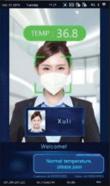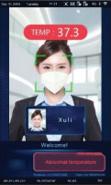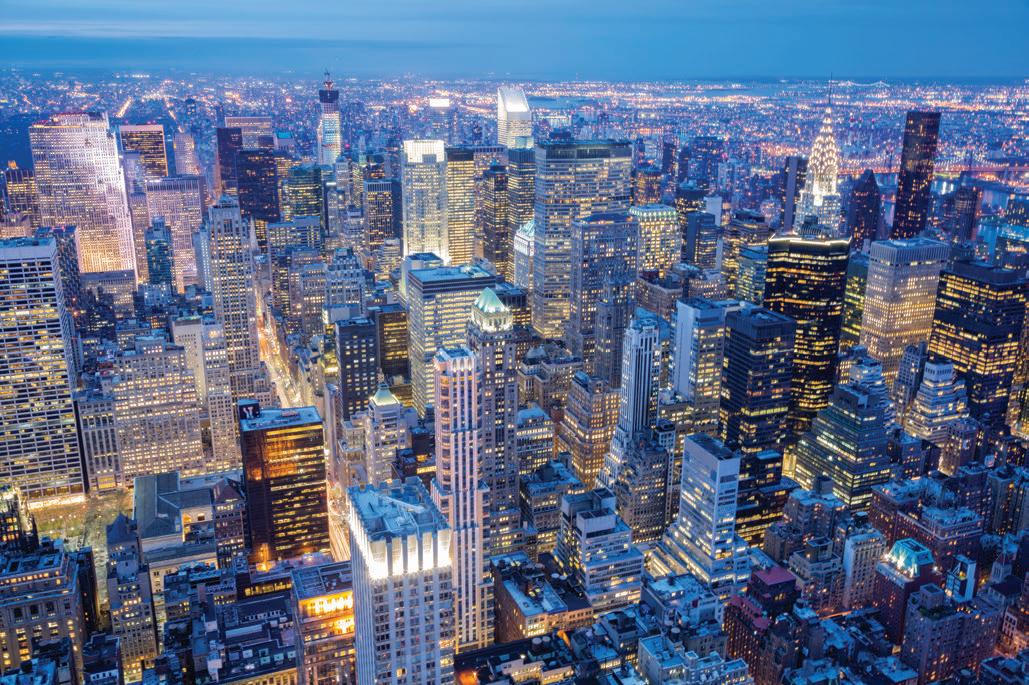

















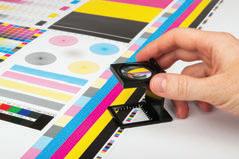
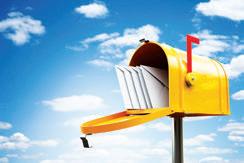
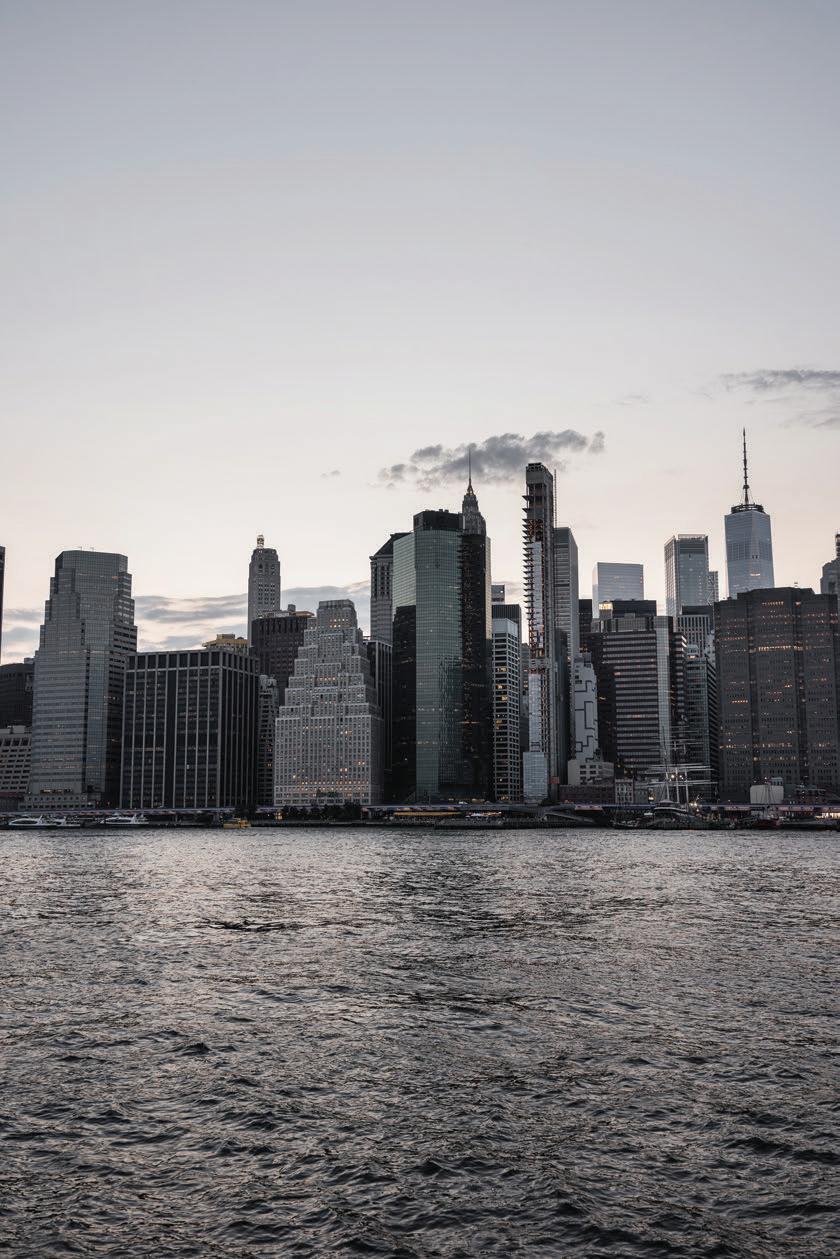


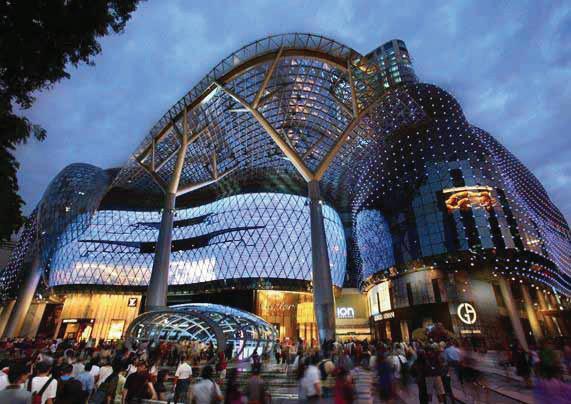
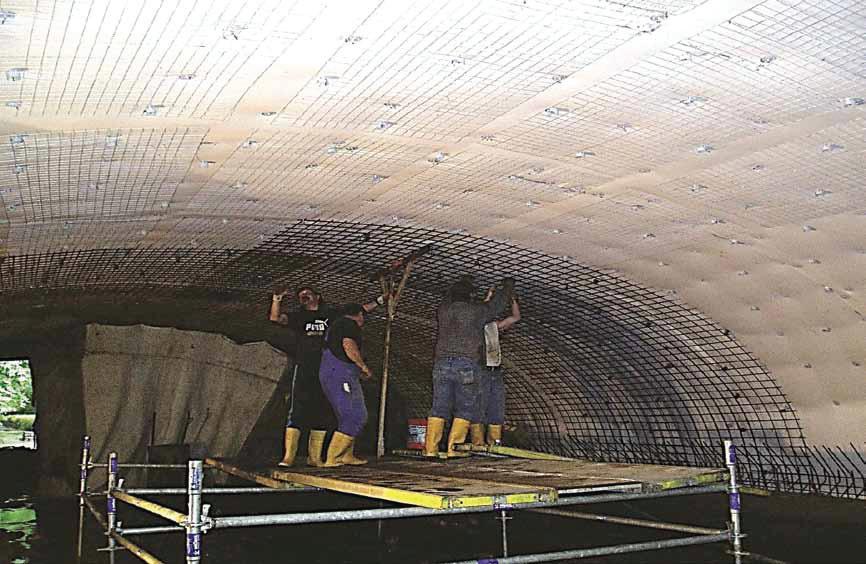
BPA-SilverSealisauniquewaterreacting,impermeable,self-healing,light-weight,swelling, nonwovenwaterproofingmembrane.Itisusedespeciallyinthefieldofstructuralwaterproofingas wellastunnelsealing.BPA-SilverSealswellingnon-wovenisaneedle-punchedPP-non-woven geotextileimpregnatedbyasuperabsorberandawateractivatedswellingpolymer(BPAEasySeal)withanoptionalhigh-densityPE-membrane(BPA-SilverSeal)Theuseofourswelling non-wovenmembraneseliminatestheneedforconventionalwaterproofingmaterialssuchas bituminousliners,coatings andsyntheticmembranesofallkinds.
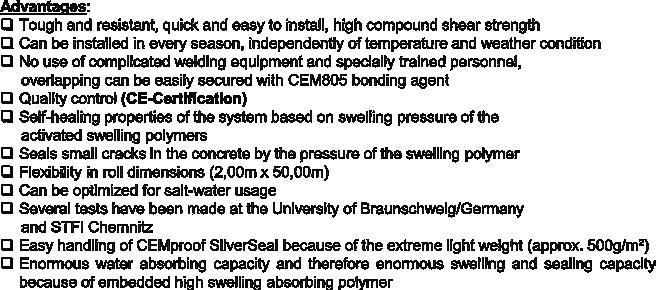
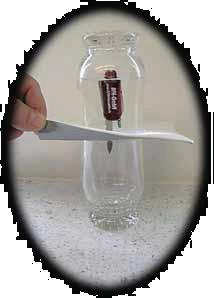


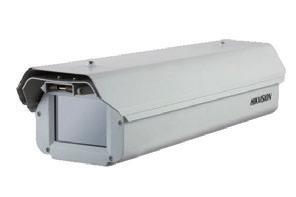

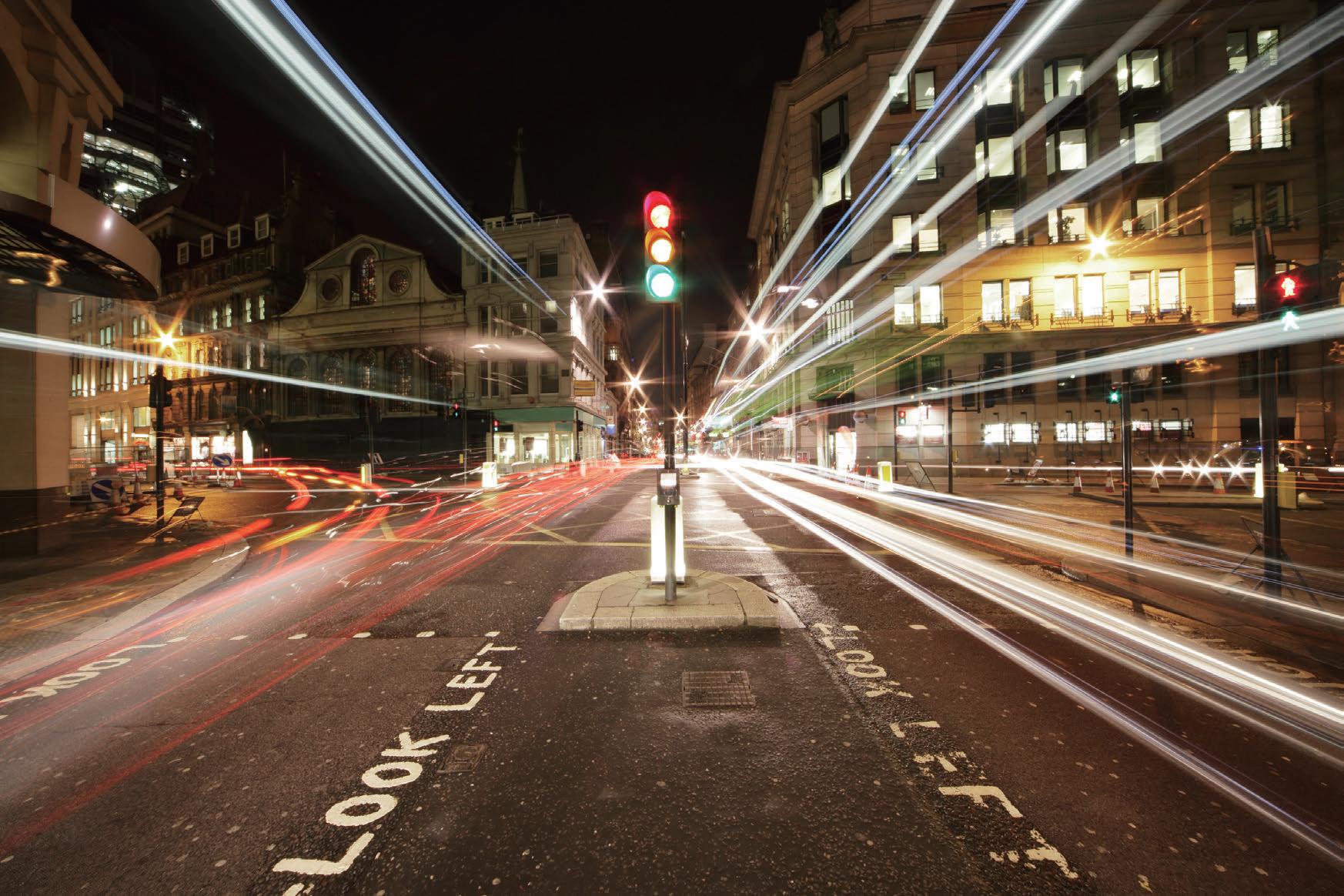

Number 04, APRIL 2021
IEM Registered on 1 May 1959
MAJLIS BAGI SESI 2020/2021 (IEM COUNCIL SESSION 2020/2021)
YANG DIPERTUA / PRESIDENT
Ir. Ong Ching Loon
TIMBALAN YANG DIPERTUA / DEPUTY PRESIDENT
Ir. Prof. Dr Norlida bt Buniyamin
NAIB YANG DIPERTUA / VICE PRESIDENTS
Y.Bhg. Dato’ Ir. Ahmad Murad bin Omar, Ir. Dr Tan Chee Fai, Ir. Mohd Aman bin Hj. Idris,
Ir. Dr Wang Hong Kok, Ir. Prof. Dr Leong Wai Yie, Ir. Mohd Khir bin Muhammad, Ir. Prof. Dr Ruslan bin Hassan
SETIAUSAHA KEHORMAT / HONORARY SECRETARY
Ir. Dr David Chuah Joon Huang
BENDAHARI KEHORMAT / HONORARY TREASURER
Ir. Chen Harn Shean
BEKAS YANG DIPERTUA TERAKHIR / IMMEDIATE PAST PRESIDENT Ir. David Lai Kong Phooi
BEKAS YANG DIPERTUA / PAST PRESIDENTS
Y.Bhg. Academician Tan Sri Datuk Ir. (Dr) Hj. Ahmad Zaidee bin Laidin, Y.Bhg. Dato’ Ir. Dr Gue See Sew, Y.Bhg. Dato’ Paduka Ir. Keizrul bin Abdullah, Y.Bhg. Academician Tan Sri Dato’ Ir. Prof. Dr Chuah Hean Teik, Y. Bhg. Dato’ Ir. Lim Chow Hock
WAKIL AWAM / CIVIL REPRESENTATIVE
Ir. Yap Soon Hoe
WAKIL MEKANIKAL / MECHANIC AL REPRESENTATIVE
Ir. Dr Aidil bin Chee Tahir
WAKIL ELEKTRIK / ELECTRICAL REPRESENTATIVE
Ir. Francis Xavier Jacob
WAKIL STRUKTUR / STRUCTURAL REPRESENTATIVE
Ir. Gunasagaran Kristnan
WAKIL KIMIA / CHEMICAL REPRESENTATIVE
Ir. Prof. Dr Lee Tin Sin
WAKIL LAIN-LAIN DISPLIN / REPRESENTATIVE TO OTHER DISCIPLINES
Ir. Dr Bhuvendhraa Rudrusamy
WAKIL MULTIMEDIA DAN ICT / ICT AND MULTIMEDIA REPRESENTATIVE
Ir. Jeewa Vengadasalam
WAKIL JURUTERA WANITA / WOMEN ENGINEERS REPRESENTATIVE
Ir. Rusnida bt Talib
WAKIL BAHAGIAN JURUTERA SISWAZAH / YOUNG ENGINEERS SECTION REPRESENTATIVES
Dr Yew Weng Kean, Mr. Kuugan Thangarajoo, Mr. Lim Yiren, Ms. Tiang Kor Lin, Mr. Tan Teck Ying
AHLI MAJLIS / COUNCIL MEMBERS
Y.Bhg. Dato’ Ir. Nor Hisham Mohd Ghazali, Ir. Toh Chin Kok, Ir. Dr Jeyanthi Ramasamy, Ir. Yim Hon Wa, Ir. Yam Teong Sian, Y.Bhg. Dato’ Ir. Fakharazi bin Wahijan, Ir. Yasotha Ramachandran Chetty, Ir. Mohmad Asari bin Daud, Ir. Ng Beng Hooi, Ir. Dr Lai Khin Wee, Ir. Dr Tan Kuang Leong, Ir. Mah Siew Kien, Y.Bhg. Dato’ Ir. Mohd Azmi bin Ismail, Ir. Ng Yong Kong, Ir. Dr Mui Kai Yin, Y.Bhg. Dato’ Ir. Noor Azmi bin Jaafar, Ir. Ting Chek Choon, Ir. Sukhairul Nizam bin Abdul Razak, Ir. Lai Sze Ching, Y.Bhg. Dato’ Ir. Dr Ahmad Anuar bin Othman, Ir. Dr Chan Swee Huat, Ir. Ellias bin Saidin, Ir. Mohd Radzi bin Salleh, Dato’ Ir. Hj. Anuar bin Yahya, Ir. Dr Teo Fang Yenn, Ir. Prof. Dr Jeffrey Chiang Choong Luin AHLI MAJLIS / COUNCIL MEMBERS BY INVITATION
Y.Bhg. Dato’ Seri Ir. Dr Zaini bin Ujang, Ir. Dr Lee Yun Fook, Ir. Fam Yew Hin PENGERUSI CAWANGAN / BRANCH CHAIRMAN
1. Pulau Pinang: Ir. Yau Ann Nian
2. Selatan: Ir. Wong Yee Foong
3. Perak: Ir. Simon Yeong Chin Chow
4. Kedah-Perlis: Ir. Mohamad Shaiful Asrul bin Ishak
5. Negeri Sembilan: Ir. Chong Chee Yen
6. Kelantan: Ir. Shaipuddin bin Shapii
7. Terengganu: Ir. Abdullah Zawawi bin Mohamad Noor
8. Melaka: Ir. Puvanasvaran a/l Perumal
9. Sarawak: Ir. Haidel Heli
10. Sabah: Ir. Jeffrey Ng Vun Ping
11. Miri: Ir. Wong Siong Ung
12. Pahang: Ir. Ahmad Kamal bin Kunji
AHLI JAWATANKUASA INFORMASI DAN PENERBITAN/ STANDING COMMITTEE ON INFORMATION AND PUBLICATIONS 2020/2021
Pengerusi/Chairman: Ir. Prof. Dr Leong Wai Yie Naib Pengerusi/Vice Chairman: Ir. Fam Yew Hin Setiausaha/Secretary: Ir. Lau Tai Onn Ketua Pengarang/Chief Editor: Ir. Dr Leong Wai Yie Pengarang Prinsipal Buletin/ Principle Bulletin Editor: Ir. Dr Bhuvendhraa Rudrusamy Pengarang Prinsipal Jurnal/Principal Journal Editor: Ir. Dr David Chuah Joon Huang Pengerusi Perpustakaan/Library Chairman: Ir. C.M.M. Aboobucker Ahli-Ahli/Committee Members: Ir. Ong Guan Hock, Ir. Yee Thien Seng, Ir. Chin Mee Poon, Ir. Dr Oh Seong Por, Ir. Prof. Dr Abdul Aziz bin Abdul Samad, Dr Sudharshan N. Raman, Ir. Dr Lai Khin Wee, Ir. Tiong Ngo Pu, Ir. Dr Lee Tin Sin, Ir. Yam Teong Sian, Ir. Yap Soon Hoe, Ir. Toh Chin Kok
LEMBAGA PENGARANG/EDITORIAL BOARD 2020/2021 Ketua Pengarang/Chief Editor: Ir. Dr Leong Wai Yie Pengarang Prinsipal Buletin/ Principle Bulletin Editor: Ir. Dr Bhuvendhraa Rudrusamy Pengarang Prinsipal Jurnal/Principal Journal Editor: Ir. Dr David Chuah Joon Huang Ahli-ahli/Committee Members: Ir. Lau Tai Onn, Ir. Ong Guan Hock, Ir. Yee Thien Seng, Ir. Dr Oh Seong Por, Dr Sudharshan N. Raman, Ir. Dr Lai Khin Wee Secretariat: Janet Lim, May Lee
THE INSTITUTION OF ENGINEERS, MALAYSIA Bangunan Ingenieur, Lots 60 & 62, Jalan 52/4, P.O. Box 223, (Jalan Sultan), 46720 Petaling Jaya, Selangor Darul Ehsan. Tel: 603-7968 4001/4002 Fax: 603-7957 7678 E-mail: sec@iem.org.my Homepage: http://www.myiem.org.my
5 COVER NOTE & EDITOR’S NOTE
6 - 12 COVER STORY
Promoting Active Transportation to Achieve Low Carbon City
16 - 30 FEATURE
Signalised Pedestrian Crossing Focusing on Visually Impaired Pedestrians – Have We Seen It?
Active Mode of Transportation Initiatives Towards Low Carbon Campus: Myth or Reality?
Practical Design of Pile Groups to Resist Horizontal Thrusts
ENGINEER’S LENS
Old Mosque with Rocket Shaped Tower
Active Transportation: Pathways to Healthy Living
Aircraft Air Inlet Cowl: Corrosion during Long Term Parking 41 - 42
Future Transportation of Malaysia 2030 Infographic Poster Competition 33 - 37 FORUMS
PAGE
PAGE

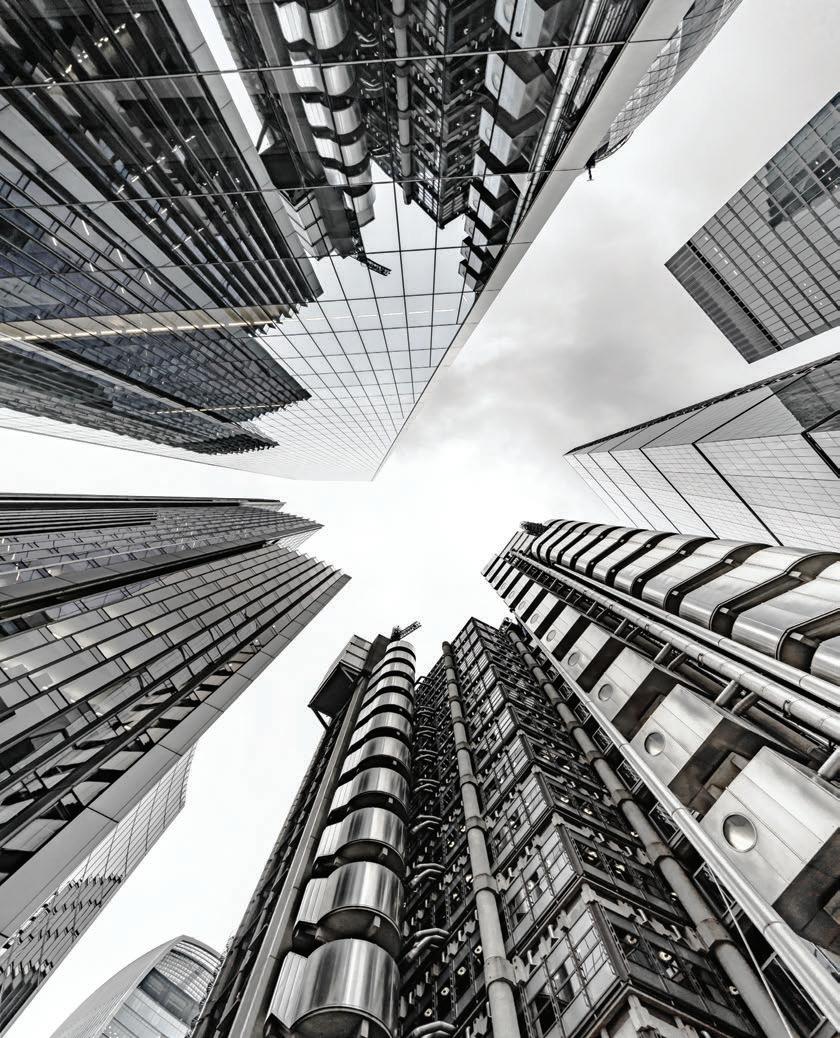
3,200/page RM 3,200/page
Full-Colour Advertisement
This one-time-only special rate o er is for new advertisers.
Space availability is subject to booking on a first-come-first-served basis.
Clients will provide ready-to-print artwork in PDF format with 300dpi.
Full page: 210mm x 285mm, 5mm extra bleed sizes for 4-sided with crop mark.
Advertising space must be utilised before 30 June 2021.
*Please note that the above rate will be subjected to 6% SST. For overseas advertisers, an additional 25% will be charged.
Rate shown above excludes 15% advertising agency commission.
Payment term: Full advance payment.
Artwork submission deadline is on (or before) the 1st week of the prior month of publication. After the material deadline, no cancellation or alteration to the advertisement will be entertained.
Any cancellation after signing the advertising order will result in a 50% penalty charge.
The publisher reserves the right to edit, revise or reject any advertisement deemed unsuitable or inappropriate.
JURUTERA has an estimated readership of 200,000 professionals. Our esteemed readership consists of certi ed engineers, decision making corporate leaders, CEOs, government o cials, project directors, entrepreneurs, project consultants, engineering consulting rms and companies involved with engineering products and services. Circulation & Readership Pro le
DIMENSION PUBLISHING SDN. BHD. [ 199701034233 (449732-T) ]
Level 18-01-02, PJX-HM Shah Tower, No. 16A, Persiaran Barat, 46050 Petaling Jaya, Selangor Darul Ehsan, Malaysia.
Tel: +(603) 7493 1049 Fax: +(603) 7493 1047
E-mail: info@dimensionpublishing.com Website: www.dimensionpublishing.com
CHAIRMAN
ROBERT MEBRUER
CEO/PUBLISHER
PATRICK LEUNG
GENERAL MANAGER
SHIRLEY THAM ● shirley@dimensionpublishing.com
HEAD OF MARKETING & BUSINESS DEVELOPMENT
JOSEPH HOW ● joseph@dimensionpublishing.com
PRODUCTION EDITOR
TAN BEE HONG ● bee@dimensionpublishing.com
CONTRIBUTING WRITERS
PUTRI ZANINA ● putri@dimensionpublishing.com
LAURA LEE ● laura@dimensionpublishing.com
SENIOR GRAPHIC DESIGNER
SUMATHI MANOKARAN ● sumathi@dimensionpublishing.com
GRAPHIC DESIGNER
SOFIA ● sofia@dimensionpublishing.com
ADVERTISING CONSULTANTS
THAM CHOON KIT ● ckit@dimensionpublishing.com
ACCOUNTS CUM ADMIN EXECUTIVE
YEN YIN ● yenyin@dimensionpublishing.com
For advertisement placements and subscriptions, please contact: DIMENSION PUBLISHING SDN. BHD. [ 199701034233 (449732-T) ]
Level 18-01-02, PJX-HM Shah Tower, No.16A, Persiaran Barat, 46050 Petaling Jaya, Selangor Darul Ehsan, Malaysia. Tel: +(603) 7493 1049 Fax: +(603) 7493 1047 E-mail: info@dimensionpublishing.com
Subscription Department E-mail: info@dimensionpublishing.com
JURUTERA is published and printed monthly by Dimension Publishing Sdn. Bhd.
JURUTERA MONTHLY CIRCULATION: OVER 50,000 MEMBERS
Submission or placement of articles in JURUTERA could be made to the:Chief Editor
THE INSTITUTION OF ENGINEERS, MALAYSIA (IEM) Bangunan Ingenieur, Lots 60 & 62, Jalan 52/4, P.O. Box 223 (Jalan Sultan), 46720 Petaling Jaya, Selangor. Tel: +(603) 7968 4001/4002 Fax: +(603) 7957 7678 E-mail: pub@iem.org.my or sec@iem.org.my IEM Website: http://www.myiem.org.my
© 2020, The Institution of Engineers, Malaysia (IEM) and Dimension Publishing Sdn. Bhd.
PUBLICATION DISCLAIMER
The publication has been compiled by both IEM and Dimension with great care and they disclaim any duty to investigate any products, process, services, designs and the like which may be described in this publication. The appearance of any information in this publication does not necessarily constitute endorsement by IEM and Dimension. There is no guarantee that the information in this publication is free from errors. IEM and Dimension do not necessarily agree with the statement or the opinion expresssed in this publication.
COPYRIGHT
JURUTERA Bulletin of IEM is the official magazine of The Institution of Engineers, Malaysia (IEM) and is published by Dimension Publishing Sdn. Bhd. The Institution and the Publisher retain the copyright over all materials published in the magazine. No part of this magazine may be reproduced and transmitted in any form or stored in any retrieval system of any nature without the prior written permission of IEM and the Publisher.
by Ir. Dr Khoo Hooi Ling Chairman, Highway and Transportation Engineering Technical Division
Active transportation refers to modes of transportation powered by humans, such as walking or bicycling. With the advance of modern technology, bicycles were replaced with motorised vehicles which provided faster travel speed, long-distance travel and higher comfort levels.

Today, streets are designed to mainly cater to motorised vehicles, while non-motorised vehicles and users are sidelined. Cyclists and pedestrians are exposed to safety risks as their needs are not being considered in road designs. Thus, there is a need to address and rectify this so that all road users can enjoy equal rights on the road.
Proper design guidelines are necessary to serve as a reference for traffic and highway engineers to design a complete street that will also cater to nonmotorised users. These guidelines spell out clearly the design requirements for cyclists and pedestrians. Common features and facilities considered are sidewalks, bicycle lanes and parking facilities, zebra crossings, traffic calming devices, median islands, kerb extensions, pedestrian signals etc. In Malaysia, the Arahan Teknik (Jalan) 10/86: A Guide on the Design of Cycle Track is used as the reference for the design of bicyclist-related facilities.
In this month’s JURUTERA, the Highway & Transportation Engineering Technical Division (HTETD) presents the issues and challenges of active transportation in the country. We hope this will public awareness of and support for bicycling or walking as a transportation mode in our daily lives.
by Ir. Dr Bhuvendhraa Rudrusamy Principle Bulletin Editor
One essential skill that most of us pick up during childhood is riding a bicycle. While kids may wobble and scrap their knees initially, the skill stays with them for a lifetime.
The bicycle is a perfect means of transportation, with long-term environmental benefits in reducing carbon emission. In addition, it is simply fun to cycle with family and friends and it benefits both our physical and mental health as well as promote learning in children.

Due to the COVID-19 pandemic, sales of bikes boomed as people looked to bicycles as an alternative means of public transportation that allowed physical distancing to minimise the risk of virus infection and as a form of exercise. With this surge in demand, bicycle production worldwide could not keep up, leading to a shortage.
In tune with the current momentum, additional cycling infrastructure such as safe and efficient cycling routes, safe bike docking stations, refreshment areas, pedestrian connection routes, water stations, etc., especially in an urban area, will be encouraging. The benefits and the impacts of cycling are multifold, and this month’s Bulletin shares some insight on active transportation.
On behalf of the Editorial Board, I would like to wish our Muslims members Happy Ramadan Kareem.

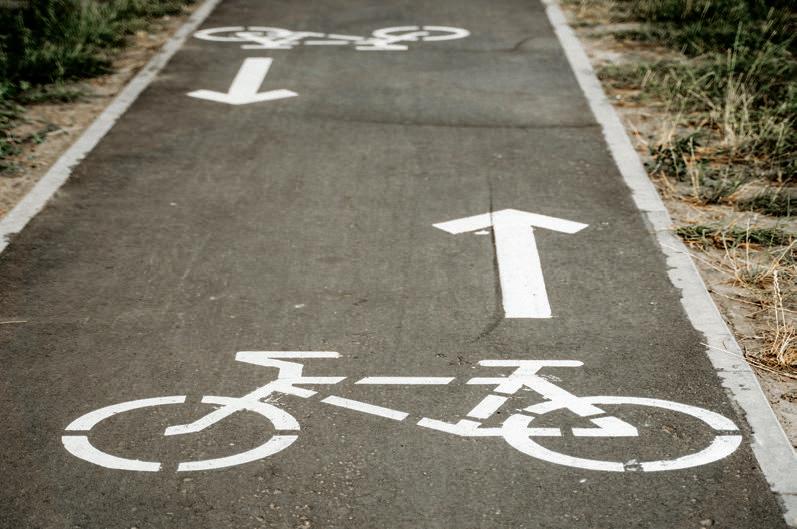
Active transportation refers to the movement of people or goods using non-motorised modes and is based on human physical activity.
By Ir. Dr Khoo Hooi Ling, Ir. Ong Sheng How & Ir. Dr K. S. Asitha
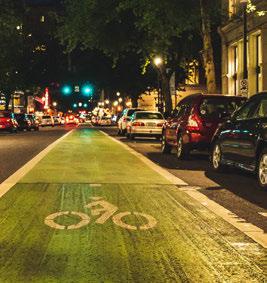
Well-known modes of active transportation are walking and cycling, although scooters, roller skates, jogging and skateboarding can also be considered active transportation modes. Promoting and engaging active transportation as a daily transportation mode brings benefits to not only society but also to the economy and the environment.
Society: Active transportation encourages people to exercise for recreation and to build physical activities into their daily routines. A healthier society with lower obesity rates and chronic diseases can be achieved if active transportation becomes a way of life.
Economy: Active transportation has emerged as an important transportation mode that addresses the first-mile and last-mile predicament for public transportation systems. Experiences from abroad show that many train passengers use bicycles to get to the station from their original location and vice versa. This can alleviate local traffic congestion in the vicinity of the station as well as increase public transportation ridership. It also improves the viability of public transportation as well as minimises economic losses due to traffic congestion.
Environment: Active transportation encourages low carbon travel,
which will subsequently reduce carbon dioxide and carbon monoxide emissions. Although active transportation brings about various tangible benefits, its popularity in Malaysia remains low. In this issue of JURUTERA, our objective is three-fold.
1. To explore the status of active transportation in our country.
2. To present case studies of active transportation in our country and other countries with advanced active transportation.
3. To investigate opportunities for improvement in active transportation.
We hope this article will increase awareness of active transportation among engineers and attract greater participation in the future. There is an urgent need to look into our design guidelines concerning active transportation and perhaps to enhance existing guidelines to reflect the importance of active transportation in our mobility provision.
As Malaysia is a highly autodependent and car-centric country, walking and bicycling are not preferred modes of transportation for most people, even for short trips. Some of the perceived barriers cited for this are as follows:
1. Climate: Our weather is hot, with frequent downpours of rain and this deters cycling.
2. Culture and habit: Walking and cycling are not habits inculcated from young.
3. Facilities: Lack of pedestrian and bicycling facilities, for example, bicycle lanes, bicycle parking facilities and others. However, this can be perceived as a chickenand-egg problem as facilities are not built or provided due to lack of demand, while users claim that the lack of facilities discourages them from walking or cycling.
4. Planning and design: The roads and environment are not planned or designed to include active
transportation users.
5. Connectivity: There is a lack of connectivity of active transportation facilities. For example, bicycle lanes are planned only near transit stations without connections to nearby building or destinations. Likewise, footpaths and pedestrian crossings are also usually provided only in the immediate vicinity of transit stations and do not reach a bigger area.
Despite the low popularity of active transportation among Malaysians, the government has made concerted efforts to encourage it. This subsection aims to present related guidelines in providing bicycle and pedestrian facilities and some case studies of active transportation implementation in the country.
Guidelines: Three guidelines are reviewed relating to cyclists and pedestrians. The Arahan Teknik (Jalan) 10/86: A Guide on the Design of Cycle Track (in short; ATJ 10/86) published by the Public Works Department, provides guidelines on how to design bicycle tracks. There are two types of bicycle tracks: Restricted track and exclusive track.
The restricted bicycle track creates a corridor that allows cyclists to move almost freely on the existing roads via road markings in easily distinguishable colours. In this design, the bicycle lane is placed between the kerb and the parking lane.
For the exclusive bicycle track, a separate route is built for bicycles and does not cross with motorised vehicles in any form. Such a design separates the cyclist and motorist to avoid conflict in both forms of overpass and underpass facilities (Figure 1).
The guideline specifies in detail the bicycle lane design requirement elements, including design speed, horizontal, vertical and crosssectional elements. The lane width recommended is based on the
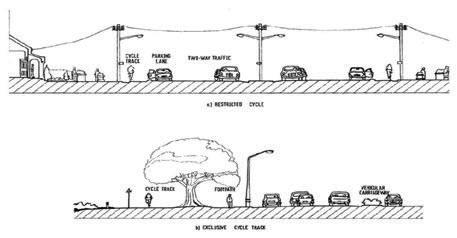
volume of cyclists, with a minimum width of 2m for a minimum volume of 1,000 cyclists per hour. It is also recommended that there should be some treatment at intersections to cater to the cyclist when the volume does not exceed 30% of the total volume at the intersection. If it should exceed 30%, a gradeseparated intersection treatment is recommended.
In 2013, PLANMalaysia (PLANMalaysia 2013) published a comprehensive guideline on bicycle lanes which provided conceptual designs for bicycle-related facilities. It covered a wide variety of elements, such as bicycle lanes, bicycle route planning, integration of bicycle lanes with road networks, integration of bicycle lanes with transit stations and recommendations on the implementation.
In terms of pedestrian facilities design, the Public Works Department Malaysia published the Nota Teknik (Jalan) 18/97: Basic Guidelines on Pedestrian Facilities (NT 18/97). The facilities considered in the guidelines included crossing facilities, speed control, intersection treatment and footpaths.
There are several efforts made by various local authorities to promote active transportation. This sub-section will highlight three such initiatives or case studies.
Kuala Lumpur South West Bicycle Corridor (KLSWC): The KLSWC by KL City Hall (DBKL) was opened to the public in 2015. It stretches from Dataran Merdeka to Mid-Valley, a total length of 5.5km. It was constructed over a period of 2 years and at a cost of RM700,000. The objective is to inculcate a cycling culture and habit for people staying along the Corridor, which is well equipped with CCTVs and is frequently patrolled by enforcement officials to ensure the safety and security of cyclists.
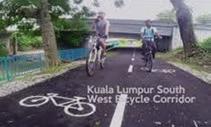
https://www.youtube.com/ watch?v=Ww5YFI5b4Hc&t=21s)
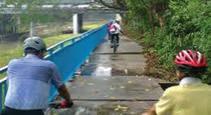
carbon city status by 2030. The effort began a few years ago when the road tarmac was painted blue to indicate bicycle lanes in Section 4, Section 5 and Taman Tasik Shah Alam. In 2019, MBSA created 15km of bicycle lanes in Section 2 and Section 14. In the third phase, more bicycle lanes are expected to be allocated in Section 7 and Section 13. Currently, these bicycles lanes are predominantly categorised for recreational, sports and leisure activities. In time to come, cycling may emerge as one of the travelling modes for work and school trips.
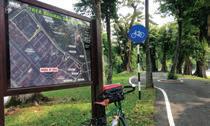
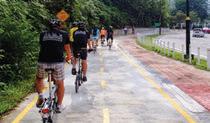
Penang Island: In line with Penang 2030 vision: A Family-Focused Green & Smart State that Inspires the Nation, the State Government has plans to increase the liveability of its people, a comprehensive green infrastructure which encompasses the Green Connectors project. One of its components is the Penang Bicycle Route Master Plan.
Introduced in 2010 and scheduled to be completed in 2021, it comprises a 200km network of bicycle lanes on the island at a cost of RM39 million (Noorhasyilah, 2020). The routes include the Eastern Coastal Route, Northern Coastal Route, Round the Island Route, Radial Route, Ring & Connector Routes, Heritage Route
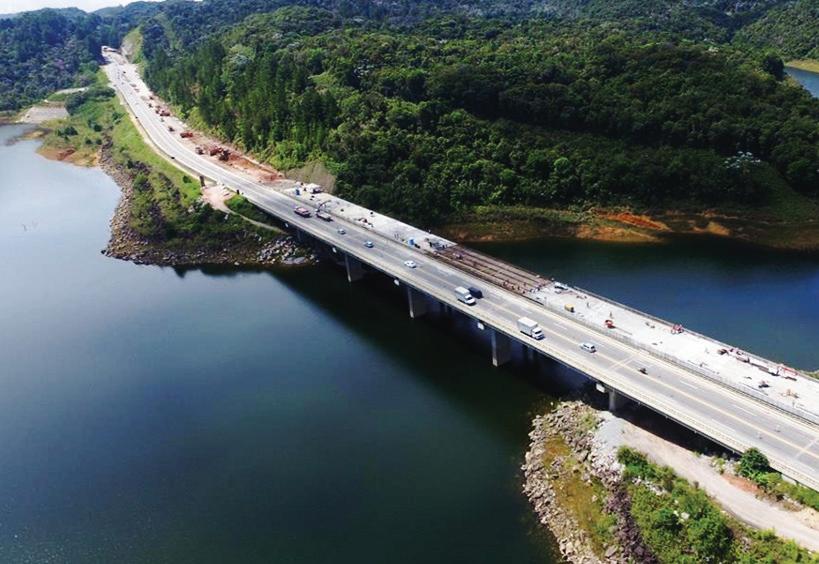
Sika S eal ®-402 Fi l le r boa r d MY is a p refor med e xpa ns ion fil l er for joints i n concret e hig hw ay s , pav i ng cu rb s, gut ter, fl oo r s and in all c on cret e b uildings a n d brick str u ct ur es
Du rab l e and easy t o ha n dl e
Withs t and r ep eat ed c ycle s of e xpan s io n and c omp r es s io n
Vi r tual l y u na ec t ed b y t empe rat ur e c hanges
Conta in s no b it u me n
No n-ab s or b en t
WISH TO KNOW MORE?
Contact our Joint Sealing specialist Kevin Oetiker at +018 288 2124 or download SikaSeal®-402 Fillerboard MY product datasheet
and Recreational Route. There are three categories of bicycle lane designs – dedicated, carriageway and shared – with lane widths of between 1.5m and 4m.
The Coastal Cycling Route stretches from Tanjung Tokong via George Town to the Sultan Abdul Halim Muadzam Shah Bridge. One component of the route is the country’s first spiral bridge for cyclists and pedestrians, Jambatan Harapan (Trisha, 2018). Located near Queensbay Mall, this iconic structure costing RM8.9 million was launched by Penang Chief Minister Chow Kon Yeow in 2018. Featuring a 3m-wide bicycle lane and 1.5m-wide pedestrian lane, the spiral bridge was created for cyclists to cross the Bayan Lepas Expressway towards Lebuhraya Sungai Nibong and the Bayan Baru roundabout.
For connectivity from Tanjung Bungah to Batu Ferringhi, an ecodeck structure with a 2m-wide bicycle lane and 1.5m-wide pedestrian lane measuring 6km long is currently being built. It is estimated to cost RM40 million.
With the Penang Bicycle Route Master Plan in place, not only will Penangites be able to cycle around the island safely, but it will also hopefully encourage both recreational and
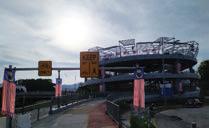
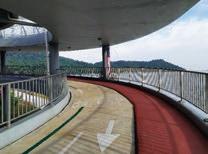
utility cycling among the people, in particular as a means of daily transportation to get to work.
Bukit Bintang-KLCC Walkway Bridge, Kuala Lumpur: This pedestrian bridge or footbridge was designed to allow pedestrians to cross busy roads in safety and, at the same time, minimise disruption to traffic. The Bukit Bintang-KLCC Walkway Bridge was opened on 28 January 2012. It is also the first fully air-conditioned walkway in the country and provides a direct linkage between the Kuala Lumpur Convention Centre (KLCC) and the Bukit Bintang area.
The bridge is 1.173km long, 5m wide and stands at the height of 535m. It traverses the busy areas of Jalan Pinang, Jalan Perak and Jalan Raja Chulan as well as connects several LRT/monorail stations. It was built to provide convenient and safe access to shopping areas, which would attract more people to use public transportation rather than cars. Indirectly, this would reduce traffic congestion within Kuala Lumpur’s Golden Triangle.
In a research study carried out by Khoo (2013), it was found that most of the users were satisfied with the bridge. The contributing factors were connectivity to shopping complexes, convenience brought about by the bridge and socio-demographics characteristics. The study suggested that more signboards and improved security should be provided as improvement strategies to allow better use of the bridge.
The Netherlands: The Netherlands is one country that dramatically depends on the bicycle as a daily transportation mode. Cycling makes up 70% of the total journey in the Netherlands. Cycling for commuting is a culture and habit it has defended for over a century. The country has in place policies and guidelines to ensure the proper development of cycling and walking facilities.
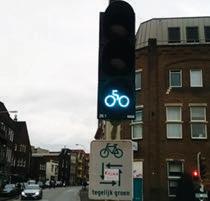

Its Cycling-Inclusive Policy Development requires the design of cycling paths to meet local choices and demands. District streets connecting the city centre, residential and shopping areas (typically two to three lanes) must be designed to prioritise walking, cycling and social activities, with particular attention to vulnerable road users. One good policy in The Netherlands is that it includes cycling facilities from the beginning of new territorial development projects by showing a Bicycle Effect Analysis. Five strategies were proposed to promote cycling in Groningen City (groningenfietsstad.nl, 2020):
1. Bicycles First – create a conducive environment that encourages cycling activities. For example, the construction of bicycle tunnels and underground parking, heated bicycle paths during snowy days, intelligent traffic lights and increased traffic safety.
2. Coherent bicycle network – overall quality improvement to the bicycle network by adding missing links, separation of cars and bicycles in the main bicycle network, fast bicycle lane, etc.
3. Space for bicycles – to improve the quality of city centre urban environment, to create new smart bicycle routes and to create apps for advice on the fastest, shortest and safest route.
4. Tailored bicycle parking – new bicycle parking allocations, removing car parking spaces for more bicycle parking, increasing the quality of bicycle parking and expanding bicycle parking capacity.
5. Cycling events and campaigns – to continuously hold cycling events and campaigns to promote and encourage more cyclists.
Scotland, The United Kingdom: Active transportation activities are well encouraged and supported in Scotland. Its government supports cycling organisations and projects by providing funding to encourage walking and cycling in Scotland (www.gov.scot). Besides financial support, it also:
1. Encourages local authorities to develop cycling strategies as part of their public transport plans and to link these with education and health initiatives
2. Provides support to local authorities for cycling projects through dedicated allocations for cycling, walking and safer streets projects
3. Tackles the school run by promoting school travel plans and active travel projects through the Places for Everyone Programme. The key principle in the design of cycling facilities is based on the cyclists’ needs and trip purposes. For example, neighbourhood trips are different from daily commuting trips. For neighbourhood trips, the requirement is to provide alternative bicycle routes with low traffic volume and speed. For commuting trips, cyclists prefer direct routes, although the traffic volume might be higher. To encourage more walking trips, Scotland launched the Let’s Go Scotland Walking Strategy in 2014.
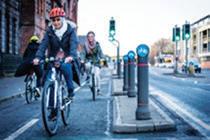
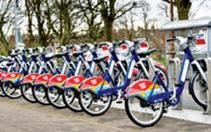
Sydney, Australia: Sydney promotes active transportation and has several detailed guidelines which govern the design and implementation of cycling and walking facilities. To achieve its objective of getting 70% of its residents to use bicycles for their daily transportation, the authorities have outlined three pillars (NSW, 2013a), namely:
1. A safe, connected network –identify missing links, identify a hierarchy of safe bicycle routes to major centres, improve bicycle parking facilities, provide cycling facilities within 5km catchment of a major centre, to be extended to 10km in the longer term.
2. To promote better use of existing infrastructure – enhance online bicycle trip planning information, work with employers and local councils to encourage more people to ride, train cycle skills, etc.
3. To engage policy and partnership –integrate bicycle infrastructure into major urban developments, partner with councils to target missing links and problem intersections in the bicycle network.
To promote walking, three pillar strategies were charted (NSW, 2013b) as follows:
1. Promote benefits of walking and provide information –promote walking trips to schools, workplaces and universities and improve quality and consistency of wayfinding and signages for pedestrians.
2. Connect through infrastructure and technology – improve pedestrian access to amenities at interchanges and support safe development.
3. Engage policy and partnership – develop policies to ensure places and major transportation developments are designed for safe walking, support programmes that promote walking and conduct promotions on walking benefits, etc.
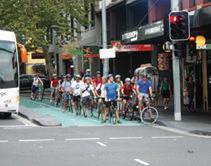
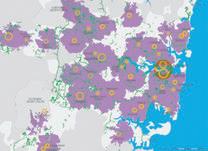
To summarise the current status in Malaysia and the lessons learnt from countries which endorse active transportation, we would like to propose the following 5 strategies as the way forward to improving active transportation.
Existing guidelines provide some conceptual design and basic principles for cycling and walking facilities. However, these are preliminary in nature and deemed insufficient to encourage a paradigm change towards active transportation. For example, the existing guidelines cover only bicycle lane designs and some concept illustration for intersection treatment. Nevertheless, other important facilities need to be considered, such as a cycling network/route/ path, bicycle parking, cycling signals, intersection treatment, physical segregation and shared space or common street features. As such, the current guidelines need to be improved to provide more comprehensive coverage of the design elements as well as indepth details of design principles for these elements.
2. Connectivity is key: Connectivity of the facilities provided for active transportation is important. For example, a bicycle lane or pedestrian walkway that is not connected to amenities/buildings does not provide any accessibility function. Imagine driving along a road that ends nowhere – would you use that particular road? Likewise, the bicycle lane and pedestrian walkway. We should consider a network of bicycle lanes or pedestrian walkways instead of only providing the facilities. If a network is not possible, the purpose and practicality of the routes should be considered at least. There are many research studies addressing useful design guidelines for an efficient bicycling/pedestrian network that provides the shortest travel path between an origin and a destination.
3. Create a friendly environment for cycling and walking: Our hot weather and frequent rains are
always cited as one reason why cycling and walking activities are less preferred. This can be countered by planting shady trees along the bicycle lanes/ routes and providing covered pedestrian walkways.These should be considered in the design guidelines as well.
4. 5km New Townships: From The Netherlands, we have learnt that new township developments should incorporate active transportation facilities at the onset of planning up to design stages. This will ensure these facilities are given thorough consideration, are well planned and are integrated into other road facilities. It is understood that the threshold of cycleable distance is about 5km, while walkable distance is about 1km. Ideally, during the master planning exercise of a development, master planners and urban designers should integrate land use with active transportation to ensure important amenities are within cycleable or walkable distances.
5. Encourage travel behavioural change: Relevant strategies are needed to encourage people to use active transportation modes, especially for short trips. This can be achieved by introducing incentive programmes to attract more cyclists and pedestrians. Research studies show that incentive programmes can effectively change travel behaviour and transportation mode choices. Researching an effective incentive programme can be one of the future directions towards inculcating active transportation as a way of life. In addition, cycling or walking events and campaigns can be organised to increase public awareness and participation. Primarily, awareness campaigns should be carried out in schools to cultivate cycling and walking habits from the young.
This article presents issues related to active transportation activities in Malaysia. Despite various efforts from the government and its agencies to promote non-motorised travel, there is lack of commitment and response from the public. Experiences from abroad provide testimonials and endorsement for our way forward. The 5 crucial strategies proposed in this article are perceived as pertinent to improving the current status of active transportation activities in our country
[1] Khoo, H.L. (2013). An analysis of willingness to use pedestrian bridge. EACEF - International Conference of Civil Engineering, [S.l.], v. 1, n. 1, p. 002, Aug. 2013. Available at: <http://proceeding. eacef.com/ojs/index.php/EACEF/article/ view/286>. Date accessed: 27 Feb. 2021.
[2] New South Wales (2013a) Sydney’s cycling future: Cycling for everyday transport. December 2013. https:// www.transport.nsw.gov.au/newsroomand-events/reports-and-publications/ sydneys-cycling-future
[3] New South Wales (2013b) Sydney’s walking future: Connecting people and places. December 2013.https:// www.transport.nsw.gov.au/newsroomand-events/reports-and-publications/ sydney%E2%80%99s-walking-future
[4] Noorhasyilah Rosli (2020). Update on the Penang Bicycle Route Master Plan, Penang Monthly, https://penangmonthly.com/article. aspx?pageid=17178&name=update_on_ the_penang_bicycle_route_master_plan
[5] PLANMalaysia (2013) Panduan Pelaksanaan Inisiatif Pembangunan Kejiranan Hijau. Penyediaan Laluan Basikal. Available at: https://rehdaselangor. com/wp-content/uploads/3c.-PenyedianLaluan-Basikal.pdf
[6] Penang Bicycle Master Plan (2019), Penang Property Talk, 4th January 2019, https://www.penangpropertytalk. com/2019/01/penang-bicycle-master-plan/ [7] Trisha,N. (2018). Penang's unique circular Harapan Bridge opens, The Star Metro News, 24th May 2018, https:// www.thestar.com.my/metro/metronews/2018/05/24/circular-landmark-forpenang-unique-600mlong-spiral-bridgeopens-to-cyclists-and-pedestrians

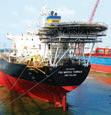
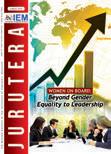







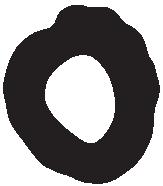








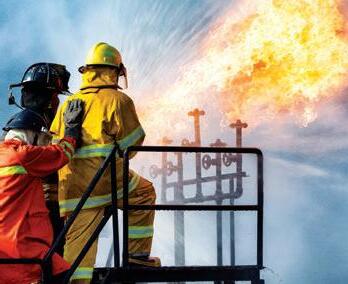
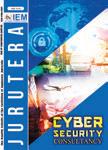









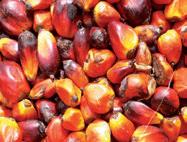

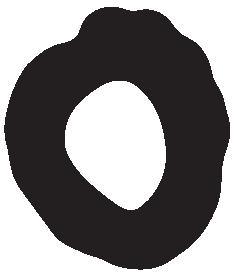



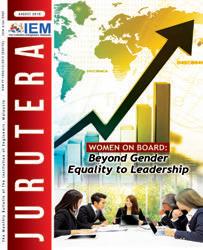
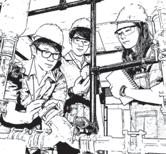





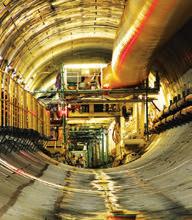

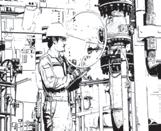













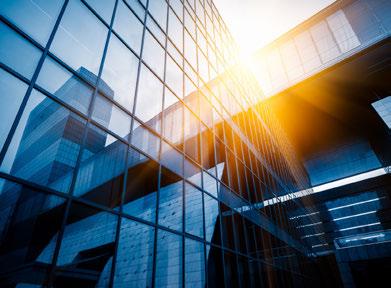

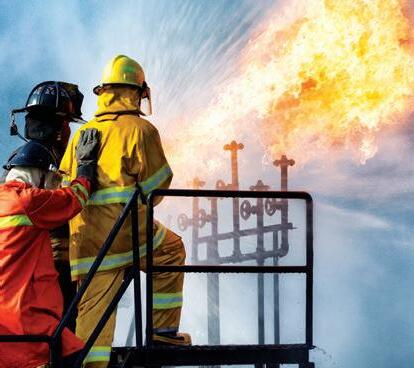










Our business partners can be assured that their products and services will be given the circulation and exposure they deserve, thus maintaining a sustained advertising presence to our core readers of decision-making engineers and technical experts. Our website offers an even wider market reach, with added international presence, aided by our international affiliation with official engineering bodies all over the world. Our online and offline advertising features such as banner advertising, article sponsorship and direct e-mail announcements have proven to be successful marketing strategies that will set the businesses of our partners apart from their competition. THE MONTHLY BULLETIN OF THE

JURUTERA has an estimated readership of 200,000 professionals. Our esteemed readership consists of certified engineers, decision making corporate leaders, CEOs, government officials, project directors, entrepreneurs, project consultants, engineering consulting firms and companies involved with engineering products and services.












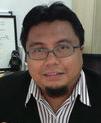
Pedestrians are categorised as vulnerable road users due to their exposure to higher risk levels during their interaction with heavy or fast motorised traffic. It is important to design pedestrian facilities and infrastructures to accommodate the needs of all pedestrians, including persons with disabilities (PWD).
The Laws of Malaysia Act 658 (2008) states that PWD shall have equal rights to access all public facilities with the same ease as persons without disabilities1. According to the Department of Social Welfare, one of the categories of PWD is the visually impaired. The World Health Organisation (WHO) defines a visually impaired person as one whose vision is worse than 3/60 in the better eye with the best possible correction and/or his/her visual field is less than 10 degrees from fixation in both eyes2
In Malaysia, statistics from the Department of Social Welfare show a total of 36,171 registered visually impaired PWD, of which 76% are above 18 years old and 24% are under 18 years old3.
Visually impaired people depend entirely on walking and using public transport to get from one place to another. One of the barriers they face is the difficulty in using the built environment and transport infrastructure, principally associated with physical design issues 4. The built environment plays a major role in determining what the visually impaired can do and Universal Design has become an important strategy for improving accessibility. For the sustainability of life, people with disabilities also need to live daily routines such as go to work, etc. and should enjoy the same ease as everyone else. The biggest challenge for PWD is to be able to cross the road safely.
Accessibility can be defined as the “ability to access”. Usually, accessibility is related to Universal Design which is the design of buildings, products or facilities that are accessible to people with various capabilities, abilities, disabilities and other characteristics. In Malaysia, one of the guidelines used by local authorities in designing buildings or facilities that involve the PWD is MS 1184:2014,
Universal Design & Accessibility in the Built Environment – Code of Practice (second revision). This Malaysian Standard provides a range of requirements and recommendations for many elements of construction, assemblies, components and fittings that comprise the built environment.
We are still lacking when it comes to considering equal accessibility and facilities for this group5. There is also a need for more innovative and good design to create a barrier-free environment and infrastructure. Concerning this problem, several studies relating to visually impaired pedestrians have been conducted, focusing on the accessibility of signalised pedestrian crossing and the interaction observation towards the crossing facilities provided.
The provision of accessible pedestrian crossing facilities is important to ensure the safety of road users, especially pedestrians. With limited capabilities, accessible pedestrian crossings are important for the PWD. In a study done by MIROS in 2019, 10 locations in Kuala Lumpur were selected to assess accessibility levels for each pedestrian crossing based on the MS 1184:2014 Code of Practice.
Before performing data collection work, a checklist of all pedestrian crossing facilities was provided. To achieve the study objective, the pedestrian crossing was assessed to ensure that they were accessible and followed established standards and guidelines.
The availability of pedestrian facilities at the signalised pedestrian crossing was evaluated. A total of 17 legs of signalised pedestrian crossing from 10 locations were evaluated. Each of these facilities had its function to ensure that signalised pedestrian crossings were accessible to all, including PWD and also to help warn other road users of the presence of PWD. See Table 1 for facilities that were evaluated at the study locations and a summary of the findings.
Curb Cuts/ Ramps
Zebra Crossing
Tactile Blocks
fair treatment for both pedestrians and motorists at the intersection.
at the signalised pedestrian crossing
Required at intersection whenever the accessible route intersects with a curb or a significant elevation change.
Designated place for pedestrians to cross the road and to keep pedestrians together so they are visible to motorists
Tactical ground surface indicators for disabled pedestrians. Need to be installed at crosswalks, curbs, ramps and edge of the pavement.
A line of bollards can encourage pedestrians to stay on marked paths
produce an audible sound to alert pedestrians that it is safe to cross
Pedestrian Crossing Sign To help pedestrians know where to cross the road and to keep pedestrians together so they are visible to motorists
Fence/ Barrier
Curb Extension
To restrict pedestrian access to the carriageway, reducing conflict between them and motorists 24%
To allow disabled pedestrians to cross intersections more easily and in a shorter time.
A device developed to increase safety by displaying the remaining time of red or green light
Based on Table 1, in complying with the guidelines, all study locations were not fully accessible to PWD (visual and physical) because the facilities were inadequate. Moreover, all 10 locations indicated that there were some deficiencies in the facilities provided and did not meet the suitable specifications.
Infrastructure characteristics, vehicular and pedestrian volume may affect the safety level of a pedestrian. To increase the level of pedestrian safety, the provision of good infrastructure alone is not enough if it is not used properly.
Other than improving accessibility in public facilities, the behaviour of pedestrians also plays an important role in ensuring their safety when crossing the road. The ability of visually impaired people is different from others. They require more information on where they are and they need to be sure they would not be walking into a carriageway6. In creating a sustainable
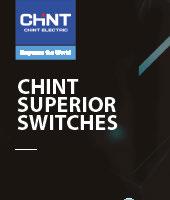
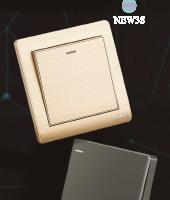
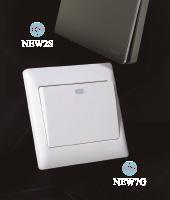

life, everyone should be allowed to lead a better daily life. Although Malaysians are known for their helpful attitude, it will be better if facilities are provided to ensure the safety of visually impaired people as they go about their daily chores, such as work, shopping, etc. Most importantly, it will increase the level of safety for visually impaired pedestrians.
To delve deeper into the interaction of visually disabled pedestrians and the facilities provided at signalised pedestrian crossings, another study was conducted in 2020 at 2 signalised pedestrian crossings in Brickfields, Kuala Lumpur. This study also assessed the crossing behaviour of visually impaired pedestrians and their temporal and spatial characteristics at the signalised pedestrian crossings. A total of 73 visually impaired pedestrians were observed over 4 hours of data collection. The data was collected using recorded video and analysed accordingly. From this study, key findings are summarised as follows:
• 68% of the 73 visually impaired pedestrians were voluntarily assisted to cross the road by other pedestrians.
• The mean crossing speed of visually impaired pedestrians at a signalised pedestrian crossing is more or less the same as other pedestrians.
• It is important to ensure that pedestrian traffic signal is designed based on their crossing speed to increase the safety level of the visually impaired pedestrian.
Temporal & Spatial Observation
• Even though there were audible devices, almost half of visually impaired pedestrians did not comply with pedestrian traffic signals.
• Through observation, those who did not comply with traffic signals, crossed the road guided by traffic conditions (possibly through hearing and using their sticks).
• Most of the visually impaired pedestrians utilised the pedestrian crossing provided. Facilities such as ramps, tactile blocks, bollards and fences helped them to cross using the right path.
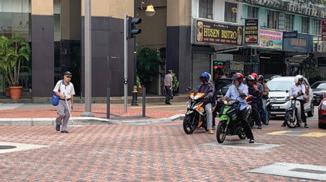
One of the United Nations’ Sustainable Development Goals is Goal 11: Sustainable Cities and Communities, which is to
make cities inclusive, safe, resilient and sustainable. In the Goal 11 target, by 2030, the government will, with the help of the media, institutions of higher education and local NGOs, provide access to safe, affordable, accessible and sustainable transport systems for all as well as improve road safety, notably by expanding public transport, with special attention on the needs of those in vulnerable situations such as women, children, persons with disabilities and older persons7
Therefore, to increase the level of sustainability of the population, especially for the disabled, local authorities need to play an important role. The local authorities need to ensure that pedestrian traffic control devices such as road markers, signs and signals are provided to ensure the information reaches the road users (pedestrians and motorists). These also need to be well maintained for optimal functions. This also applies to visually impairedfriendly pedestrian walkaways and other facilities.
In improving or designing pedestrian facilities, user feedback is of the utmost importance. To promote the friendly atmosphere of public areas for better usage and accessibility, legislation alone is not enough if it is not followed through by implementation, compliance and enforcement. Therefore, we need to learn from the success/failure of other countries to improve the situation in Malaysia.
[1] Laws of Malaysia Act 658. (2008). Persons with Disabilities Act. The Commissioner of Law Revision, Malaysia
[2] Kassim, A. B. (2020, October 26). MyHEALTH Kementerian Kesihatan Malaysia. Retrieved from Portal Rasmi MyHEALTH Kementerian Kesihatan Malaysia:http://www.myhealth.gov.my/en/blindness-visualimpairment/#:~:text=According%20to%20World%20Health%20 Organization,eye%20with%20best%20possible%20correction
[3] Department of Social Welfare. (2019, December 18). Official Portal Department of Social Welfare. Retrieved from http://www.jkm.gov.my/
[4] Bryan, M., Daryl, H., & Kasia, S. (2015). The impact of street accessibility on travel and independence of disabled people. 14th International Conference on Mobility and Transport for Elderly and Disabled Persons. Lisbon: White Rose Research Online
[5] Soltani, S. H., Sham, M., Awang, M., & Yaman, R. (2012). Accessibility for Disabled in Public Transport Terminal. Procedia - Social and Behavioral Sciences, 89-96
[6] Cheshire County Council. (2005). Pedestrian Access & Mobility – A Code of Practice. Cheshire: Cheshire County Council
[7] United Nations. (2021, February 20). United Nations Sustainable Development Goals. Retrieved from United Nations Web site: https:// www.un.org/sustainabledevelopment/sustainable-development-goals/
Authors’ Biodata
Puan Nur Zarifah Harun is with the Malaysian Institute of Road Safety Research (MIROS), doing research, in particular, on the safety of pedestrians and people with disabilities (PWD).
Ir. Ts. Dr Muhammad Marizwan bin Abdul Manan , Director for Road Safety Engineering & Environment Research Centre, MIROS, is involved in road design/safety research with focus on motorcycle safety, ITS application development, etc.

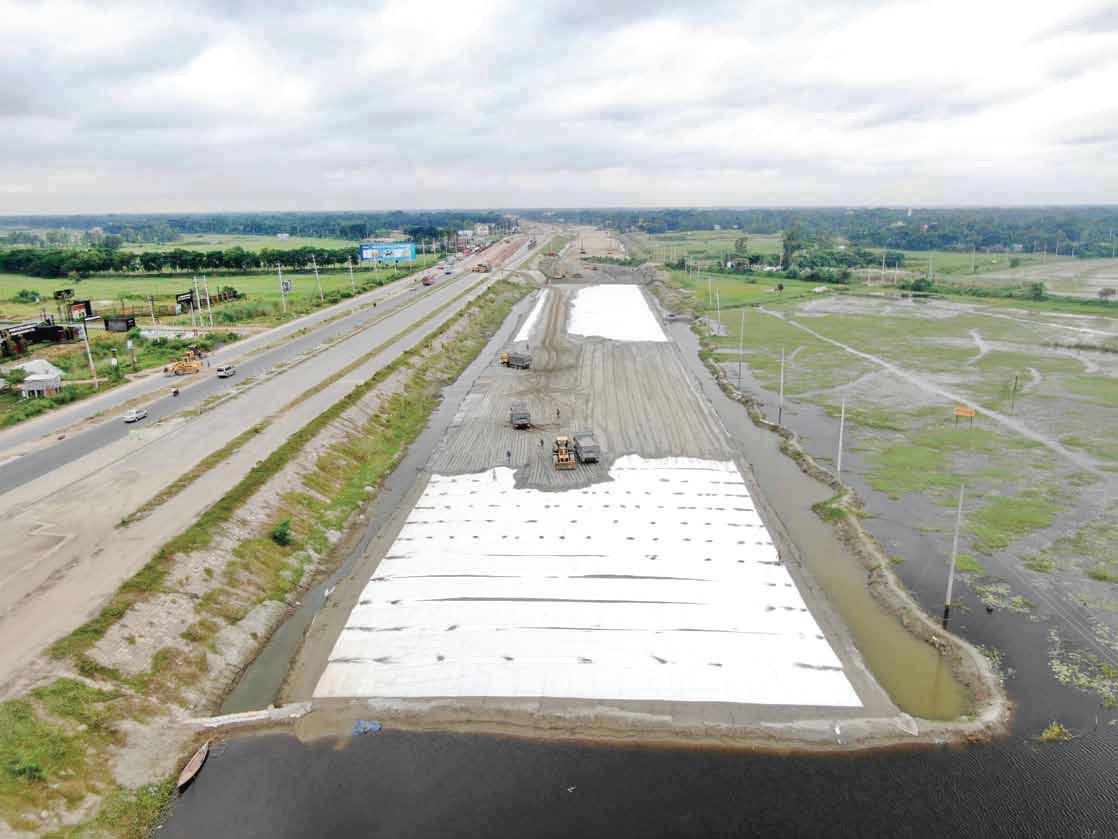





Green transportation is a vital issue in the future plans of universities. It is a realisation of green transportation initiatives of non-motorised vehicle and shared-ride mode vehicle to reduce dependency on travelling in a motorised vehicle. It is a value-added university campus that applies this policy as initiated by the UI GreenMetric World University Ranking (UIGM).
Campuses with a large population of students, staff and visitors have a higher chance of nurturing the green transportation concept and implementing the policy within a controlled traffic management system. In practicality, most of the green campus transportation concept is to monitor and reduce carbon emission caused by incampus mobility especially by motorised vehicles such as a car, motorcycle and public transportation.
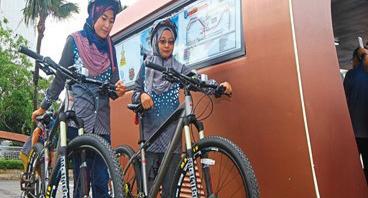
Recently, the high number of vehicles entering Universiti Teknologi MARA (UiTM), Shah Alam campus, had led to high carbon emissions, threatening non-motorised vehicle initiatives. UiTM Shah Alam has a large campus area and a population of over 53,000 students and staff; it has been considering the implementation of green transportation
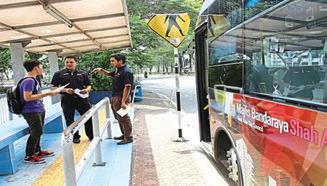
policies. These initiatives are in line with the national policy on climate change and the Majlis Bandaraya Shah Alam (MBSA) low carbon city aspiration.
Physical transportation planning plays a vital role in the whole university plan. In fact, there is a significant impact on green transportation initiatives in the university’s physical transportation planning. Green transportation initiatives comprise facilities, transportation and utilities concerned with land utilisation on campus. This initiative will also improve life quality, linking persons to employment, health, education, recreation and other amenities, especially university staff and students.
UiTM Shah Alam spreads over 300 acres of land, with faculties, hostels, Centers of Excellence, office buildings and other facilities. However, with the rapid growth of student/staff population and transportation demand, traffic congestion, noise pollution, environment/parkingrelated problems are increasing every year. UiTM’s green transportation policies and initiatives are an option to address all these issues.
The UI GreenMetric World University Ranking is an annual world university ranking system that motivates all universities to participate in and contribute toward achieving a green campus. UIGM focuses on the current initiatives and policies related to green campus and sustainability in universities worldwide. There are 6 criteria for UIGM ranking: Setting and Infrastructure (15%), Energy and Climate Change (21%), Waste (18%), Water (10%), Transportation (18%) and Education (18%).
The Transportation criteria involves pedestrian walkways, cycling bikeways, smart growth development and transportation infrastructure transit-oriented design. UiTM Shah Alam took 9th place for UIGM ranking in Malaysia and 184th place in the world for the 2020 annual UIGM ranking.
In the past decade, greenhouse gas emissions and energy demand in the transportation industry have risen faster than in any other sector. An increased campus population leads to air pollution in congested areas, gaseous emissions and particulate pollution from passenger vehicles. The implementation of green campuses is a trending topic as this will become a relevant practice to counter emissions problems. Transportation systems associated with traffic congestion and commuting activities require a holistic policy and gear planning options to encourage sustainable transport and low carbon campus.
Table 1: UIGM Criteria for Transportation in the main campus Source: https://greenation.uitm.edu.my/my/
number of vehicles (cars and motorcycles) divided by the entire campus population
Vehicles (ZEV) policy on campus
Total number of Zero-Emission Vehicles (ZEV) divided by the entire campus population
of the parking area to the total campus area
of transportation criteria implementation in the main campus, UiTM Shah Alam


Green transportation policies concentrate primarily on the preferential growth of public transportation, the enhancement of walking and cycling standards, the establishment of intelligent transportation systems, the removal of high-polluting cars and introduction of new technology vehicles. Unfortunately, the implementation of a low carbon campus policy is ineffective without the involvement and commitment of students and staff. Implementing sustainable growth needs multiple steps that vary according to the institutional context; it is worth exploring to focus on campus sustainability from diversified viewpoints. Each initiative must be in context to successfully promote green transportation on campus. University administrators worldwide are dealing with sustainability issues consequences while still introducing steps to create a healthy campus atmosphere.
Transportation Initiatives for Low Carbon Campus
1 Increase the provision of quality pedestrian infrastructure and bikeways
2 Ensure quality maintenance of bicycle and walking networks
3 Improve the walking, cycling and public transport environment facilities
4 Improve the environment for walking, cycling and public transport use, both in transit and end of trip facilitates
5 Increase and encourage more students and staff to confidently use the active mode of transport (walking and cycling) in campus.
6 Empower pedestrian walkway, bicycle lane and motorcycle lane to interact with active mode transport more considerately and safely
7 Increase social and individual awareness of active mode transport activities and campaign among staff and students.
WEBINAR - Technical Talk on “Moving Towards An Effective Carbon Management Programme A Chemical Industrial Perspective”
Date : 12 April 2021 (Monday)
Time : 5.30 p.m. – 7.30 p.m.
Venue : Digital Platform
Approved CPD : 2
Speaker : Ir. Thaya
WEBINAR - Do you want to be an ARBITRATOR?
Date : 14 April 2021 (Wednesday)
Time : 2.00 p.m. – 3.00 p.m.
Venue : Digital Platform
Approved CPD : 1
Speaker : Ir. Leon Weng Seng
WEBINAR - Introduction to Commercial Arbitration in Malaysia
Date : 15 April 2021 (Thursday)
Time : 10.30 a.m. – 11.30 a.m.
Venue : Digital Platform
Approved CPD : 0
Speakers : Mr. Kevin Prakash
Mr. Andrew S. Kalish
Congratulations to First Admiral (Rtd) YBhg. Dato’ Ir. Haji Ahmad Murad bin Haji Omar on being awarded the Ijazah Kehormat Doktor Teknologi at Majlis Konvokesyen Universiti Malaysia Terengganu Ke-18 on 27 March 2021.
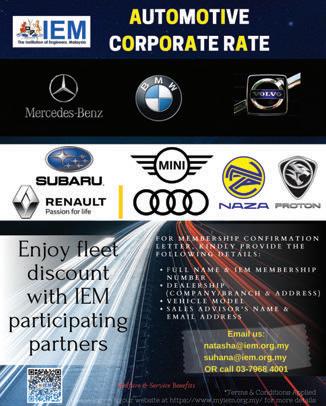

by Ir. Tan Eng Chong
The purpose of this article is to help those who have to do rough check of pile group to resist horizontal thrusts with a few simple hand calculations to explain the procedures.
The approaches are similar to those of graphical trial and error methods.
In mathematical form, these can be applied to any arrangement of piles and a required pile rake from the loading condition.
The assumptions of analyses are:
2.1 Pilecaps are rigid.
2.2 Piles are end bearing and pinned at the pile cap
PILE GROUPS CARRYING VERTICAL LOAD & HORIZONTAL THRUST
The principle illustrated in Figure 1 is that of simple balancing of external forces by the vertical and horizontal components of the resultant pile loads.
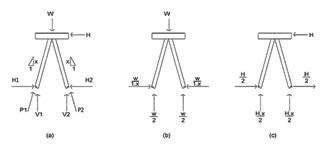
Figure 1
Referring to Figure 1 and applying as limiting conditions that no tension is to be allowed, then V2 ≥ 0 and H2 ≥ 0 Therefore
For equilibrium, rake = Z = W/H and resultant pile load = √(W2 + H2)
If W = 40 tons and H = 10 tons
Then rake required = Z = 40/10 = 4 (rake = 1 : 4) and resultant pile load = P1 = (402 + 102) = 41.23 tons P2 = 0
Alternatively, if a maximum vertical component of 5 tons tension is to be permitted, then equating the vertical components of 2 in Figures 1(b) & 1(c)
whence rake required:x = -25 = 5 (rake 1 : 5) -5

V1 = 40 + 10 x 5 = 45 tons 20 + 25 = 45 tons
H1= 45 = 9.0 tons
V2 = 40 - 10 x 5 = -5.0 tons , H2 = - 5 = - 1.0 ton 2 2 5
P1 = 26 x 45 = 45.9 tons compression 5 P2 = 26 x -5 = -5.1 tons
If the maximum permissible pile load were limited to, say 40 tons compression, then the vertical components of P1 in Fig 1 (b) & 1(c ) would have to be equated thus:
W + Hx = +40 tons
2 2
if W = 40 tons & H = 10 tons
40 + 10x = + 40 tons 2 2
x = 20 = 4 (rake 1 : 4) 5
V1 = 40 + 10x4 = 40 tons 2 2
H1 = 10.0 tons →
V2 = 40 - 40 = 0 ton
H2 = V2 = 0 4
P1 = (402 + 102) = 41.23 tons compression
P2 = 0
The simple arrangement shown in Figure 1 is to illustrate the method of determining the required rake.
For a more practical arrangement, i.e. whereby the piles do not meet at a point in the pile cap, the applied horizontal thrust again may be equally shared between the horizontal components.
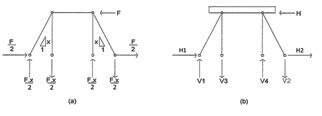
The vertical piles combined with the stiffness of the pile cap, provide the same resistance to movement as the vertical members in Figure 2(a). Hence all raking piles will resist the applied horizontal thrust with horizontal components of equal value.
The final forces in a pile group are determined by superimposition as shown below.
Column foundation (Example No. 1)
Applied loads, W = 400 tons; H = 15 tons; M = 0; 12 pile group (Figure 3) - 6 piles raked
Pile loads due to W:
V = 400 = 33.33 tons 12
H = 33.33 tons x
Pile loads due to H: H = 15 = 2.5 tons 6 V = 2.5 x tons
Again the pile rake can be determined by limiting conditions of pile loads (max. permissible say 50 tons)
33.3 + 2.5 x = 50 tons x = 16.67 = 6.67 (use rake = 1 : 6) 2.5
P1 = 37 x (33.3 + 2.5 x 6) = 49.0 tons 6
If rake x = 1:4 (x = 4) V1 = 33.33 + 2.5 x 4 = 43.33 tons ↑
H1 = 43.33 = 10.84 tons 4
V2 = 33.33 - 2.5 x 4 = 23.33 tons ↑
H2 = 23.33 = 5.84 tons 4


P1 = 17 x 43.33 = 44.67 tons P2 = 17 x 23.33 = 24.06 tons 4 4
PILE GROUPS CARRYING VERTICAL LOAD HORIZONTAL THRUST & BENDING MOMENT (EXAMPLE #2)
2 Figure 3
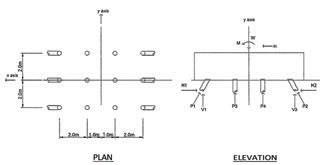
P = W ± M d Nos of piles Iyy
Again by equating the horizontal components to the applied horizontal thrust, the required pile rake can be directly determined
H = ∑H1 + ∑H2 since H1 = V1 x
∑V1 + ∑V2 = H H2 = V2 x x x
W = 400 tons
H = 15 tons
M = 350 ton m
Iyy = 6 x 12 + 6 x 32 = 60m*
V1 , = 400 ± 350 x 3 = 33.33 ± 17.5 = +50.83 tons V2 12 60 +15.83 tons
P3 , = 400 ± 350 x1 = 33.33 ± 5.8 = +39.13 tons
P4 12 60 +27.53 tons
Rake required = x = (50.83 - 15.83) x 3 = 7 15
H1 = 50.83 = 7.3 tons → H2 = 15.83 = 2.3 tons 7 7 (H1 - H2) X 3 = (7.3 - 2.3) X 3 = 15 tons (tally with H)
Author’s Biodata
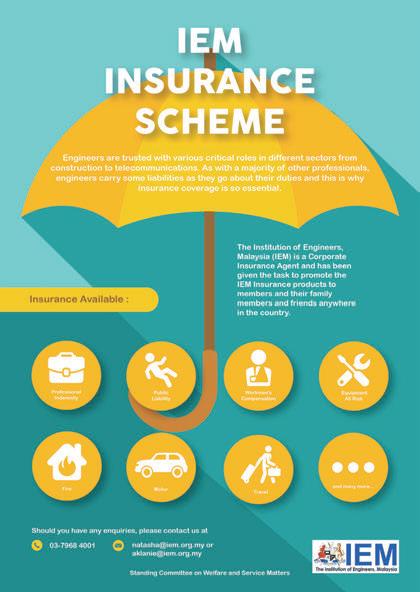
1-Day Webinar on “Online Tools for Earthquake Resistant Design of RC Buildings Based on the EC8 Malaysia NA”
Date : 24 April 2021 (Saturday)
Time : 9.00 a.m. – 5.30 p.m.
Venue : Digital Platform
Approved CPD : 0
Speakers : Nelson Lam
Dr Hing-Ho Tsang
Ir. EP. Lim
Dr Daniel Looi
Mr. Prashidha Khatiwada
Mr. Chan Rong Xiang
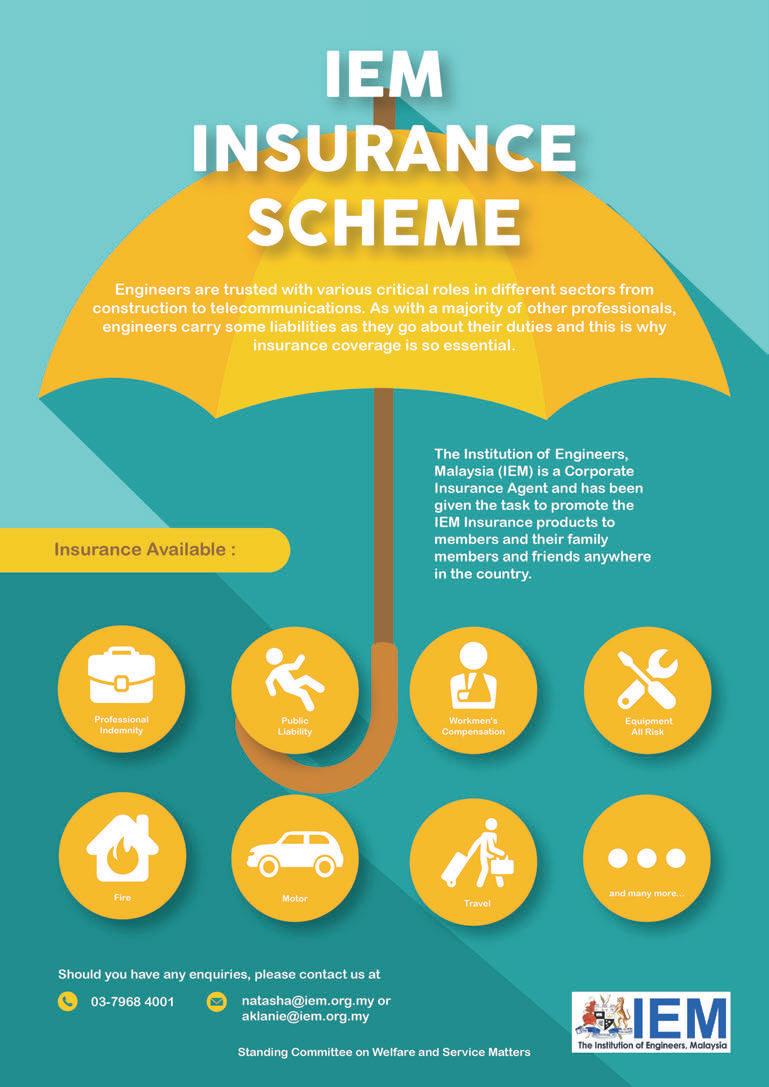
Webinar on Seismic Hazard and Risk Assessment from the Geological Perspective
Date : 28 April 2021 (Wednesday)
Time : 2.30 p.m. – 4.30 p.m.
Venue : Digital Platform
Approved CPD : Applying
Speaker : Dr Frederick Francis Tating

F lyer / Lea f le t
Art P aper (F ull Color )
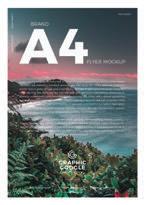
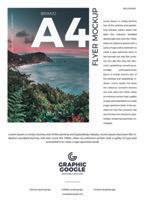


500pc s RM130 1000pc s RM160 A4 105 g sm
500pc s RM160 1000pc s RM190 128 g sm 500pc s RM100 1000pc s RM130 A5 105 g sm
s RM160 128 g sm
s RM130
Bus iness Card - 54mm x 90m m




The COVID-19 pandemic has resulted in a full-scale crisis worldwide. Border controls, travel restrictions and flight suspensions have been imposed globally as part of efforts to contain the spread of the virus. With this, aviation in particular airports, has been brought to a virtual halt and the industry is in survival mode, crippled by the loss of traffic and revenue1. Major airlines have been forced to ground many of their planes due to the low demand for flights and air travel. About 17,000 aircraft or more than 60% of all planes are currently grounded.
While maintaining aircraft on long term parking or storage may seem to require less or minimal effort, the reality cannot be more different. This unprecedented situation has left airline operators and aircraft manufacturers scratching their heads as they try to come out with the best solutions to keep the planes airworthy while on the ground.
The air inlet cowl is an aerodynamic cowl installed at the front of the engine. It directs airflow to the engine fan section and engine core, reduces engine noise through acoustic treatment and is where the thermal anti-icing (TAI) system is installed. The typical configuration of the air inlet consists of inner barrel acoustic panels, outer skin panels, a forward/ rear bulkhead and a leading-edge (lip skin) assembly. The air inlet lip skin is a C-shape nose made of aluminium alloy, usually Aluminium 2219.
The Aircraft Maintenance Manual (AMM), Maintenance Procedure (MP) or Approved Maintenance Programme (AMP) provide operators with detailed procedures for parking and storage. These procedures must be followed to preserve the safety, airworthiness and value of the aircraft2. During long term parking/storage of the aircraft, engines must be sealed with engine covers as part of the preservation procedures of the AMM, MP or AMP. Exposure to snow, ice, sand, debris, nesting birds and foreign objects
when parked long term, severe damage is caused to the expensive turbine jet engines. Although the engine cover is essential to protect the engine, there are still drawbacks in corrosion of the air inlet by installing the engine cover.
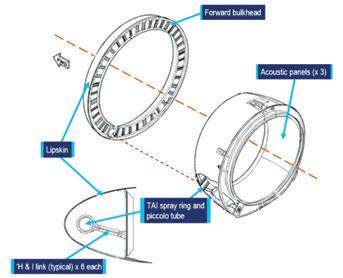
Depending on the aircraft and engine type, some engine cover designs are encapsulated in the air inlet lip skin area. One disadvantage of this design is that it traps moisture between the cover and lip skin. It gets worse during the rainy season and it is common to see water trapped in the engine cover over the lip skin area. The water and moisture will speed up corrosion build up on the lip skin.
Pitting corrosion is the most common type of corrosion on the lip skin. It can be first noticed as a white or grey
powdery deposit, similar to dust and it blotches the surface. When this is cleaned away, tiny pits or holes will be seen on the surface3.
Corrosion can render an aircraft un-airworthy by weakening structural components, roughening the outer surface and loosening fasteners. It also initiates material cracking. Corrosion is typically repaired either by blending out the affected areas, performing cut-out and lip skin section repair or replacing the entire lip skin segment.
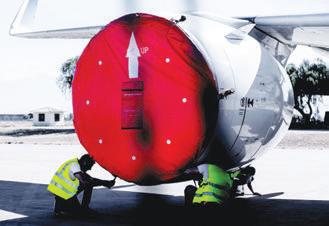
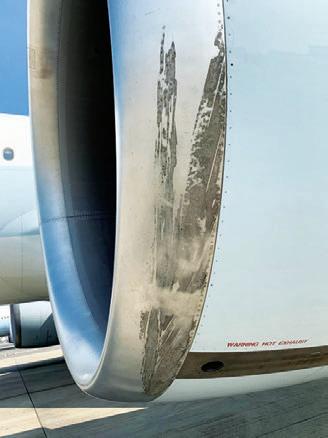
It is a challenge for airline operators to manage the issue. Not only is corrosion a cost burden in commercial aviation but it also compromises safety and performance, erodes productivity and adds a significant burden to aircraft maintenance.
Corrosion prevention compounds (CPCs) are materials that can help prevent new corrosion sites from forming and, more importantly, suppress corrosion that has already been initiated. CPCs have been used on aircrafts for many years as a relatively inexpensive method of combating corrosion. One of the main advantages of using CPCs is that little or no preparation of the affected site is required before application4. The CPC materials can be applied to the air inlet lip skin at the start of prolonged parking or storage procedure. However, as the aircraft may be subjected to regular engine ground run (EGR) requirement in the meantime, the CPCs must be thoroughly removed first to ensure it does not contaminate the engine during the EGR.
The desiccants most commonly used in the protection of aircraft parts or components are silica-gel and activated alumina. Because of their hygroscopic nature, these desiccants absorb moisture, thereby preventing corrosion5 It is good practice to put the desiccant on a mat in the air inlet and exhaust of the engine, followed by placing a humidity indicator card or strip to check that excessive moisture does not accumulate. The indicator card must be inspected regularly and the desiccant replaced when necessary to ensure the humidity level is within the required range.
Choosing the right engine cover can also help to mitigate corrosion on the air inlet lip skin. Airline operators may use the engine cover that not encasing the lip skin. It is more difficult to inspect the condition of the lip skin when the whole area is covered. The AMM, MP or AMP may have the requirement to use specific Original Equipment Manufacturer (OEM) engine covers, but it is possible to ask OEMs for approval to use alternative engine covers. Alternatively, the airlines and operators may use their design organisation approval to develop their own engine cover, a more flexible option to address the specific issue and meet their fleet requirements.
Airplanes are meant to be flown. It is not good for them to sit idle for long periods. The longer an airplane is stored, the more has to be done before it can be returned to service6
The best way to control corrosion is to keep it from forming in the first place and this can be done through regular inspection and cleaning. Airlines and operators can adjust their maintenance programme to respond to the current situation where aircrafts need to be on the ground for long periods. Visual inspection of the air inlet on a weekly basis, cleaning and drying the surface as well as
restoring the CIC coating as and when necessary will help prevent corrosion build-up on the lip skin.
Apart from corrosion, the mass grounding of aircrafts also poses many other challenges, such as where to park the aircrafts, how to keep them secure and airworthy and in a place where they can be retrieved quickly when demand picks up7. Airports are not designed for long-term storage and it will cost a huge amount of money to park aircrafts at the airport over an extended period. Besides, many airports are in less than ideal locations for long term parking and storage, especially those in humid weather and near-thesea locations.
Some airlines have opted to send their aircrafts to a dedicated storage area outside their home base. Storage areas with a dry climate are the best possible conditions as airlines wait out the coronavirus pandemic. More importantly, proper maintenance with the help of a dry environment in the storage area will make aircrafts less prone to corrosion attacks.
[1] A. Gittens (2020). Impacts of COVID-19 on aviation and the airport business. https://www.internationalairportreview.com/article/117249/ covid-19-airport-business-aci-world-recovery/
[2] P. Bertrand et al. (2020). Aircraft Parking and Storage. Airbus Safety Magazine.
[3] US Department of Transportation, Federal Aviation Administration, AC 43-4B – Corrosion Control for the Aircraft
[4] F. Gui (2009). Corrosion Control in the Aerospace Industry. https:// www.sciencedirect.com/topics/engineering/corrosion-prevention
[5] CAA New Zealand (2007). Advisory Circular AC-002, Storage and Distribution of Aeronautical Supplies.
[6] J.Cox (2020). Special to USA TODAY: Ask the Captain: What will it take to return parked airplanes to service after coronavirus? https:// www.usatoday.com/story/travel/columnist/cox/2020/04/09/askthe-captain-coronavirus-whats-involved-returning-parked-planesservice/2971609001/
[7] Anurag Kotoky, David Stringer and Ragini Sexena (2020). Here’s What You Do With Two-Thirds of the World’s Jets When They Can’t Fly. https://www.bloomberg.com/news/features/2020-04-16/ coronavirus-travel-what-happens-to-planes-grounded-by-covid-19
[8] Credit photo for Figure 1: https://www.atsb.gov.au/media/5777015/ ao-2017-059_final.pdf
[9] Credit photo for Figure 2: https://services.airbus.com/en/newsroom/ news/2020/04/parking-and-storing-aircraft-special-covid-19-update.html.
Author’s Biodata
Ir. Edie Noreffendi Abdul Kadir , Lead Technical Services Engineer (Aircraft Structures) with Cathay Pacific Airways, has worked in aircraft maintenance and aviation for over 14 years.
Webinar on Geological Assessment of the Earthquake Sources and Hazard in Malaysia
Date : 30 April 2021 (Friday)
Time : 2.30 p.m. – 4.30 p.m.
Venue : Digital Platform
Approved CPD : Applying
Speaker : Mr. Bailon Golutin
WEBINAR - Half-Day Webinar on Automatic Transfer Switch Based on MS IEC 69047-6-1
Date : 4 May 2021 (Tuesday)
Time : 9.00 a.m. – 1.00 p.m.
Venue : Digital Platform
Approved CPD : Applying
Speaker : Mr. Ritesh Lutchman
Webinar Talk on “The Holistic Treatment Approach of Raw Water and Boiler Water in the Agricultural Based Industries Particularly in the Rural Area”
Date : 8 May 2021 (Saturday)
Time : 11.30 a.m. – 1.30 p.m.
Venue : Digital Platform
Approved CPD : 2
Speaker : Mr. Yan Long Yeow
2-Day Course on “CIPAA & Adjudication – Latest Trends”
Date : 24 - 25 May 2021 (Monday - Tuesday)
Time : 9.00 a.m. – 5.00 p.m.
Venue : Wisma IEM
Approved CPD : 14
Speaker : Ir. Lai Sze Ching
Webinar Talk on “Introduction to Simulations –Fundamentals and Applications”
Date : 25 May 2021 (Tuesday)
Time : 3.00 p.m. – 5.00 p.m.
Venue : Digital Platform
Approved CPD : Applying
Speaker : Ir. Abd Malik Hussein
Rasah, located about 3km from Seremban, was a rich tin mining area in the 18th century. Miners transported tin ore via boats along the Linggi River which flowed by a harbour in Kampung Rasah. It was recorded that the British had appointed the late Haji Ahmad bin Haji Ali as the harbour master (Dato Syahbandar) to monitor the movement of boats and to collect taxes.
In 1850s, more settlements were opened at Kg Rasah. Not long after that, Haji Ahmad built Masjid Jamek Dato Bandar Haji Ahmad, one of the earliest mosques in Negeri Sembilan.
The mosque was built with an initial size of 20x42ft, which was sufficient to accommodate 50-60 worshippers. Then, with continuous donations from the community, the mosque was renovated and expanded in stages in 1970, 1985, 1990 and 2006. Today the mosque can cater to more than 1,000 worshippers.
A unique tower shaped like a rocket was erected behind the mosque. The mosque still retains its original structures such as the large columns in the main hall. The mosque is flanked by the Seremban Middle Ring Road and Interchange Highway to Port Dickson and motorists who use these roads can clearly see the rocket-shaped tower.
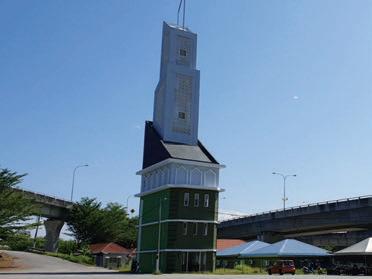

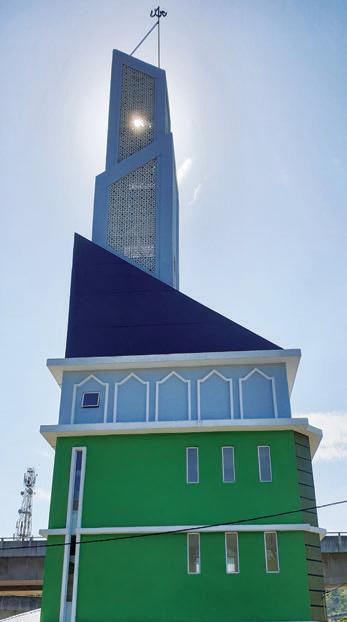
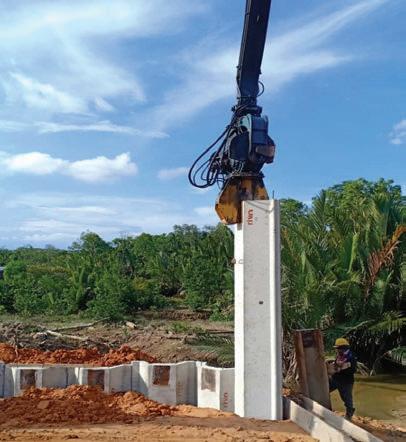
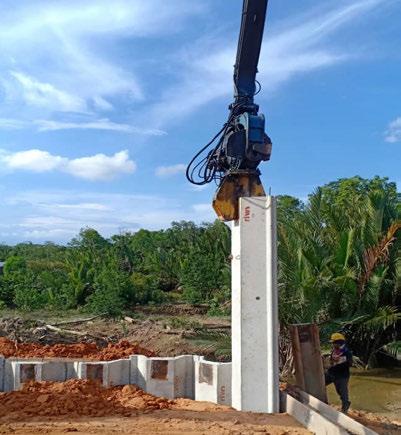



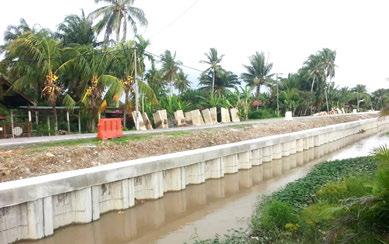

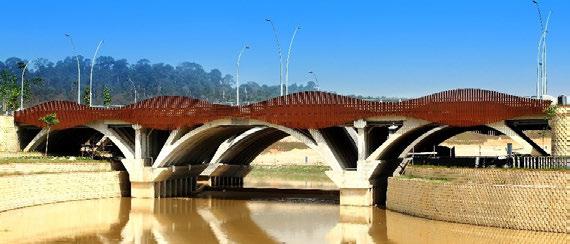
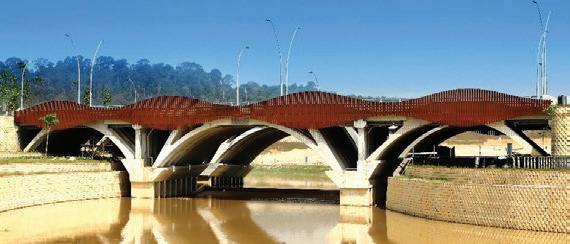

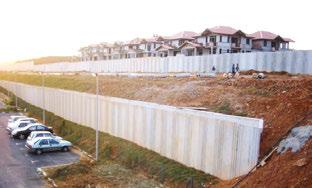



by Ir. Dr K.S. Asitha Ir. Ong Sheng How
Due to the Covid-19 MCO, the transportation seminar on Active Transportation – Pathways To Healthy Living, scheduled for 18 March 2020, was postponed. It was finally held on 29 September 2020 and the 40 participants had been waiting for this interesting seminar with eagerness.
The Highway & Transportation Engineering Technical Division (HTETD) had invited 3 speakers: Datin TPr Noraida Saludin, Mr Lee Hwok Lok and Datin TPr Hjh Mazrina Dato’ Abdul Khalid.
Datin Noraida spoke on the Impact of Active Mobility With Mode Share & Sustainable Development in Malaysia. She was of the opinion that our ATJs should be revised to incorporate modern planning elements such as shared spaces. Shared streets mean that cycling, pedestrians, social activities, parking and motorised vehicle traffic are combined to create shared public spaces.
A positive environment and social impacts can be achieved through shared spaces. She said we should give the streets back to the people instead of giving them solely to motorised vehicles. To encourage active transportation, she suggested that we introduce a “road/ street diet” (a new term that refers to road calming techniques), collect data on cycling and walking, draw out a good action plan and implement good designs from overseas such as the Dutch-style intersections and roundabouts.
Mr. Lee’s talk was on Benefits of Active Transportation –Health, Environment & Economy. There are three aspects of health: Physical, psychological and social. For physical health, activities such as walking and cycling will result in physical fitness as well as help improve mental health, which is associated to psychological health. Active transportation can initiate good social relationships because people who walk or cycle are more likely to meet and converse with each other and this interaction can lead to a stronger sense of community and togetherness.
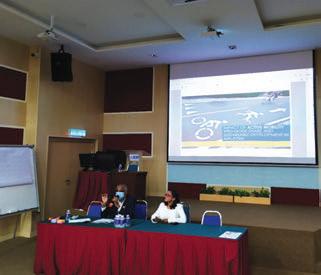
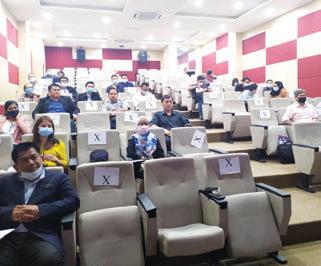
Our products:




Motorised transportation emits particulate matter, nitrogen dioxide and carbon monoxide; it is the major source of air pollution in urban areas and the second highest source of carbon dioxide and greenhouse gas emission. So, active transportation reduces pollution, saves space and reclaims road space for more green space. These are some benefits that active transportation has on the environment. As for economic benefits, active transportation can contribute to cost saving, increase retail visibility and volume, enhance property value and boost economic growth due to support for local businesses.
Among the barriers to active transportation in Malaysia are climate and air quality, commuting distance, inadequate infrastructure and public attitude and perception.
Datin Mazrina spoke on the Definition & Relationship with Public Transportation – Urban Design and TOD (transit-oriented development) Concept including:
1. An overview of the local transportation planning process
2. An understanding of TOD policies and development practices at Federal, state and local levels
3. A study on the integration criteria between urban design and TOD concept.
The 12 criteria in integrating urban design with the TOD concept are mixed development, high intensity, mobility, parking, park and ride, affordable houses/commercial, open spaces, public facilities, iconic/unique, safe and inclusive city, low carbon city planning and smart initiatives.
There is a distinction between TOD and TAD (transit-adjacent development). TODs are located within a 400m radius from the transit station and TADs are located within a 400-800m radius from the transit station.
In a TOD area, mobility should be well connected via walking, cycling or riding a bus. Due to the close proximity to public transportation, parking provisions within a TOD area should be reduced. For TOD, people can leave their vehicles at home and use public transportation instead. With a TOD, the emphasis is on live-work-play within walking/cycling distances and easy access to public transportation.
In his concluding speech, Tuan Haji Ir. Cheremi bin Haji Tarman, the Director of the Engineering Department, Majlis Bandaraya Shah Alam (MBSA), said he hoped active transportation will become a way of life for Malaysians.
Active transportation, particularly walking and cycling, is an important and essential mode of mobility in a well-planned, sustainable city. Walking and cycling can be combined with other modes, such as public transit, to provide people with a well-connected mobility experience in the first and last mile travel, in line with the sustainable development goals to achieve a better and more sustainable future for all. So let us all contribute to help our country build sustainable, walkable, non-motorised vehicle friendly and transit-oriented cities.
No. 45-3, Jalan PJU 5/20
The Strand, Kota Damansara 47810 Petaling Jaya Selangor Darul Ehsan : 012 355 9151 : 012 329 3378 (Whatsapp only)
Tel : 603 6142 6638
Fax : 603 6142 6693
Email : leehuiseng@nehemiahwalls.com
Email : enquiry@nehemiahwalls.com
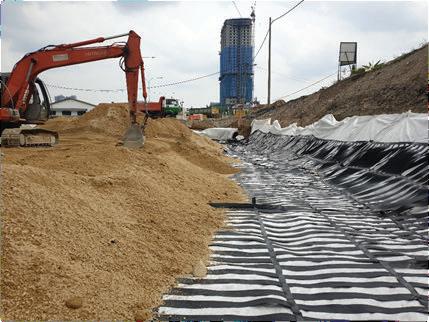
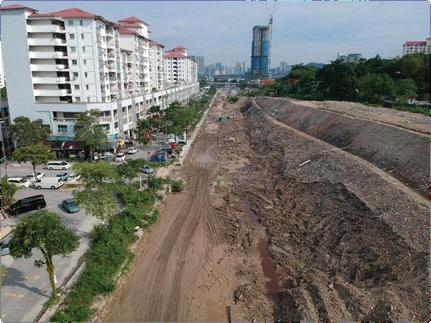

The increase of complexity and environmental challenges in Civil Engineering require solu ons using geosynthe cs.
Maccaferri Geosynthe cs have been and con nue to be used in all aspects of the transporta on industry including, roadways, railroads, retaining walls, slopes, and waterways. Maccaferri o ers speci c solu ons to cater to sophis cated challenges op mising value and simplifying your project.
Maccaferri Geosynthe cs are commonly used for:
Drainage
Filtra on Protec on Reinforcement
Separa on Erosion Control Barrier
Stabilisa on Stress Relief
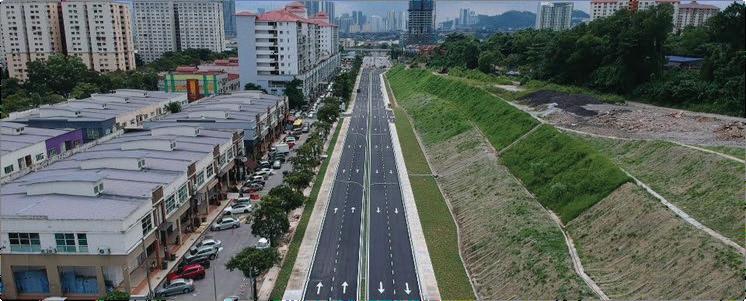
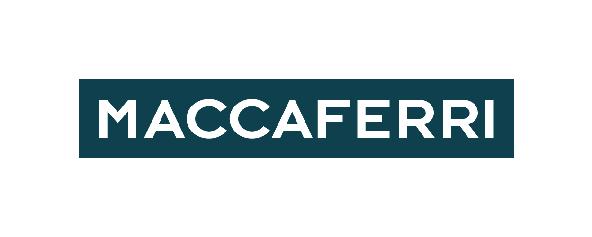





by Syed Khairi Syed Abbas
The Highway & Transportation Engineering Technical Division (HTETD), Institute of Engineers, Malaysia (IEM), organised the Future Transportation of Malaysia 2030 Infographic Poster Competition.
The competition was held through the IEM official website and HTETD Facebook website from 1 June to 1 September 2020. There were 37 participants, including groups of students from Infrastructure University Kuala Lumpur (IUKL), Universiti Sains Malaysia (USM), Universiti Tunku Abdul Rahman (UTAR) and private individuals.
Students from the Department of Civil Engineering & Construction, Faculty of Engineering, Science and Technology (FEST), IUKL, swept away the 1st and 2nd Prizes while the 3rd Prize was won by a private individual.
The 1st Prize winners were Turki Abdulrahman Saleh Hussein, Naif Abdulrahman Saleh Hussein and Mohamed Luqman Abdirashid.
The 2nd Prize winners were Alemad Ahmed Nasser Saleh, Alsewari Ahmed Mahfoudh Mohammed and Barashed Habeb Obaid Awadh.
The 3rd Prize went to Ir. Begum Irdawati binti Dowlad Rahuman.
In line with the theme, Future Transportation of Malaysia 2030, participants had to consider various types of transport, including but not limited to train, bus, car, motorcycle, bicycle and pedestrian. The idea for the theme came from The National Transport Policy 20192030 published by the Ministry of Transport Malaysia.
On 12 December 2020, the Chairman of HTETD, Associate Professor Ir. Dr Khoo Hooi Ling, awarded the winners a certificate each and cash prizes of RM500, RM300 and RM200, respectively.
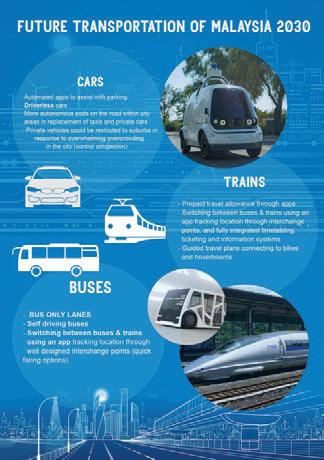
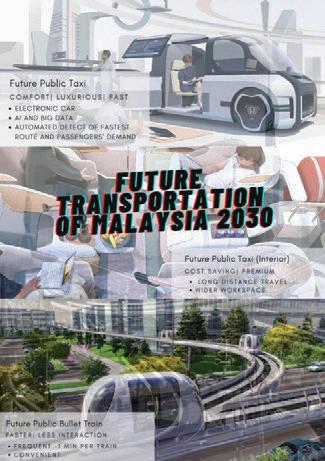
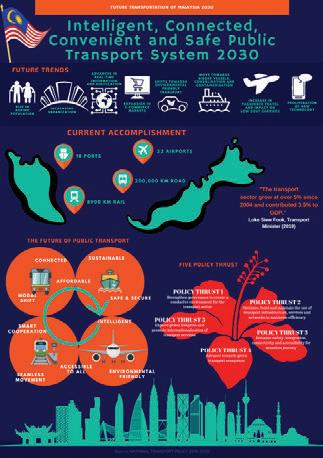
Webinar Talk on “Hazardous Materials Management”
Date : 27 May 2021 (Thursday)
Time : 3.00 p.m. – 5.00 p.m.
Venue : Digital Platform
Approved CPD : Applying
Speaker : Ir. Dr Salmaliza binti Salleh
Webinar Talk on From Waste To Become Wealth - You Can Do It In Palm Oil Mill
Date : 28 May 2021 (Friday)
Time : 3.00 p.m. – 5.00 p.m.
Venue : Digital Platform
Approved CPD : 2
Speaker : Ir. Hor Kok Luen
Webinar Talk on “The Chemical Waste Water Treatment Processes In The Food Industry”
Date : 29 May 2021 (Saturday)
Time : 9.00 a.m. – 11.00 a.m.
Venue : Digital Platform Approved CPD : Applying
Speaker : Mr. Yan Long Yeow
Webinar - 5G Technology: Challenges & Opportunities
Date : 29 May 2021 (Saturday)
Time : 11.30 a.m. – 1.30 p.m.
Venue : Digital Platform
Approved CPD : 2
Speaker : Mr. Mohan Albert





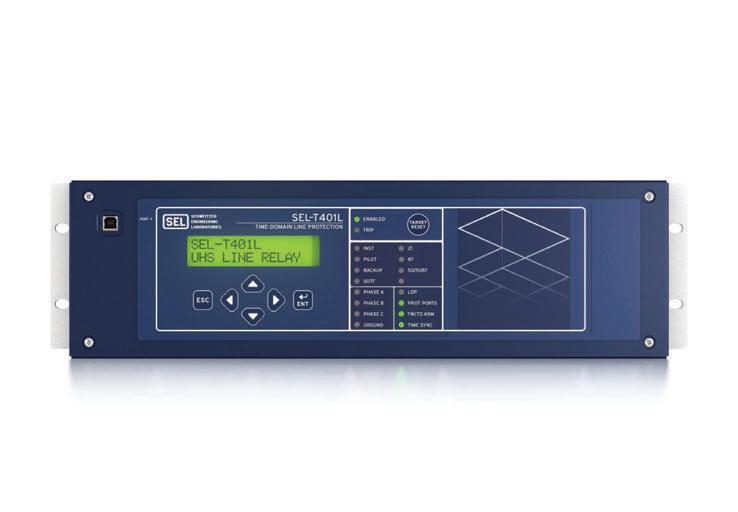
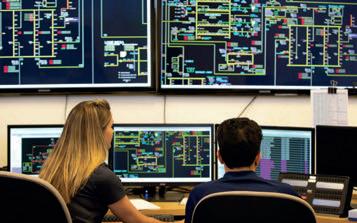


Tarikh: 11 Mac 2021
Kepada Semua Ahli,
CALON-CALON YANG LAYAK MENDUDUKI
TEMUDUGA PROFESIONAL TAHUN 2021
Berikut adalah senarai calon yang layak untuk menduduki Temuduga Profesional bagi tahun 2021.
Mengikut Undang-Undang Kecil IEM, Seksyen 3.8, nama-nama seperti tersenarai berikut diterbitkan sebagai calon-calon yang layak untuk menjadi Ahli Institusi, dengan syarat bahawa mereka lulus Temuduga Profesional tahun 2021.
Sekiranya terdapat Ahli Korporat yang mempunyai bantahan terhadap mana-mana calon yang didapati tidak sesuai untuk menduduki Temuduga Profesional, surat bantahan boleh dikemukakan kepada Setiausaha Kehormat, IEM. Surat bantahan hendaklah dikemukakan sebulan dari tarikh penerbitan dikeluarkan.
Ir. Dr David Chuah Joon Huang Setiausaha Kehormat, IEM (Sessi 2020/2021)
PERMOHONAN BARU
Nama Kelayakan
KEJURUTERAAN AWAM
MOHD FAHIZAN BIN
IBRAHIM BE HONS (UTM) (CIVIL, 2001)
MOHD KHAIRUL BIN
KAMARUDIN BE HONS (UTM) (CIVIL, 2005) MSc (SURREY) (BRIDGE, 2007) PhD (SURREY) (2015)
KEJURUTERAAN ELEKTRIKAL
MUHAMAD HELMI BIN
ABDUL MAJID BE HONS (UiTM) (ELECTRICAL, 2008)
KEJURUTERAAN KIMIA
BAN ZHEN HONG BE HONS (UMS) (CHEMICAL, 2009) MSc (USM) (CHEMICAL, 2011) PhD (UTP) (CHEMICAL, 2016
NOORSURIA BINTI SURADI BE HONS (UTM) (CHEMICAL, 2006) ME (UPM) (ENVIRONMENTAL, 2014)
SITI WAHIDAH BINTI
PUASA BE HONS (USM) (CHEMICAL, 2004) MSc (USM) (CHEMICAL, 2006)
PERMOHONAN BARU / PERPINDAHAN MENJADI AHLI KORPORAT
Nama Kelayakan
KEJURUTERAAN KIMIA
CHONG CHING CHIENG BE (MANCHESTER) (CHEMICAL, 2010 MSc (IMPERIAL COLLEGE LONDON) (ADVANCED CHEMICAL ENGINEERING WITH BIOTECHNOLOGY, 2011)
DEWIKA NAIDU A/P
MUNISAMY NAIDU BE (UTM) (CHEMICAL, 2000) ME (UTM) (ENVIRONMENTAL, 2003) PhD (UTM) (2019)
KEJURUTERAAN AWAM
AHMAD HAZRY BIN HASHIM BE HONS (UTM) (CIVIL, 1993)
SHAZLINA BINTI
SHAHARUDIN BE HONS (UTM) (CIVIL, 2006)
PERPINDAHAN AHLI
No. Ahli Nama Kelayakan
KEJURUTERAAN BIOKIMIA
75347 MUHAMMAD RASHID BIN SHAMSUDDIN BE HONS (IIUM) (BIOCHEMICALBIOTECHNOLOGY, 2007) PhD (WAIKATO) (2013)
KEJURUTERAAN ELEKTRIKAL
72725 CHUA HOCK GUAN BE HONS (UTHM) (ELECTRICAL, 2010) ME (UTHM) (ELECTRICAL, 2013)
90068 FONG WAI HING BE HONS (UTP) (ELECTRICAL & ELECTRONICS, 2014)
112711 LEE YAN KANG BE (CARLETON) (ELECTRICAL, 2015)
58715 MOHD HANIF BIN ZAHARI @ JOHARI BE HONS (UTeM) (CONTROL, INSTRUMENTATION & AUTOMATION, 2011)
97487 MUHAMAD AFIQRI BIN IBRAHIM BE HONS (UNITEN) (ELECTRICAL POWER, 2013)
36871 MUHAMMAD MUZAWAHIR BIN LIJONG BE HONS (UiTM) (ELECTRICAL, 2004)
KEJURUTERAAN AWAM
36989 AWANG ZAIDELADHA BIN AWANG REDZUAN BE HONS (USM) (CIVIL, 2005)
23739 BONG HIN JOO, CHARLES BE HONS (UNIMAS) (CIVIL, 2003) ME (UTM) (CIVIL-HYDRAULIC & HYDROLOGY, 2006) PhD (USM) (2014)
44784 LAI CHIN LEONG BE HONS (UTP) (CIVIL, 2011)
102383 MUHD AL HAFIZ BIN MUHAMMAD YUSOFF BE HONS (UniMAP) (BUILDING, 2013)
54243 RAZWAN BIN ABDUL RASHID AHMAD BE HONS (UTP) (CIVIL, 2011) MSc (UTM) (PETROLEUM, 2014)
81419 TAN TOH XIN BE HONS (NOTTINGHAM) (CIVIL, 2013) MSc (NOTTINGHAM) (GEOTECHNICAL, 2014)
95863 WAN MUHAMMAD HAFIZ BIN ZAKARIA BE HONS (UiTM) (CIVIL, 2011) MSc (CARDIFF) (CIVIL, 2017)
95801 ZETTY SHAZLIN BINTI MOHAMED BE HONS (UTM) (CIVIL, 2011)
KEJURUTERAAN KIMIA
20463 LIM TIEN SHING BE HONS (UPM) (CHEMICAL, 2002) MSc (MANCHESTER) (ADVANCED CHEMICAL PROCESS DESIGN, 2014)
PERMOHONAN BARU/PERPINDAHAN MENJADI AHLI KORPORAT No. Ahli Nama Kelayakan
KEJURUTERAAN AWAM
22449 KHAIRULANUAR BIN MUHARI BE HONS (UKM) (CIVIL, 2000) ME (UTM) (CIVIL, 2013)
53802 SYED MOHD NAZERI BIN SYED NORIHAN BE HONS (UKM) (CIVIL & ENVIRONMENTAL, 2007)
KEJURUTERAAN ELEKTRIKAL
78434 CHAN CHI YEN BE HONS (UPM) (ELECTRICAL AND ELECTRONICS, 2015)
42480 KHAIRUL BIN FAIZAL BE HONS (UTHM) (ELECTRICAL, 2006)
SENARAI PENDERMA KEPADA WISMA DANA BANGUNAN IEM
Institusi mengucapkan terima kasih kepada semua yang telah memberikan sumbangan kepada tabung Bangunan Wisma IEM. Ahli-ahli IEM dan pembaca yang ingin memberikan sumbangan boleh berbuat demikian dengan memuat turun borang di laman web IEM http://www.iem.org.my atau menghubungi secretariat di +603-7968 4001 / 5518 untuk maklumat lanjut. Senarai penyumbang untuk bulan Februari 2021 adalah seperti jadual di bawah:
NO. NO. AHLI NAMA
20933 MR. ROZMAN BIN KASMANI
25174 MR. MOHD RAPHEL AFFENDY BIN MOHAMED NAZAR 3 28363 MR. NAZRI BIN AMINUDIN 4 95901 MR. DUALI MUNSIN
15793
97493
105571
CHANG CHEE CHEONG
CHEONG JAN XI
SYAIFALIZAN AKMA BINTI HAJI JAMALUDIN
MUTHUKUMAR A/L KALIMUTHU
PERMOHONAN BARU / PEMINDAHAN AHLI
Persidangan Majlis IEM yang ke-422 pada 27 Julai 2020 telah meluluskan sebanyak 1,201 ahli untuk permohonan baru dan permindahan ahli. Berikut adalah senarai ahli mengikut disiplin kejuruteraan:
Senarai nama ahli dan kelayakan adalah seperti di bawah. Institusi mengucapkan tahniah kepada ahli yang telah berjaya.
Ir. Dr David Chuah Joon Huang
Setiausaha Kehormat, Institusi Jurutera Malaysia, Sesi 2020/2021
PERMINDAHAN AHLI KEPADA AHLI FELLOW
No. Ahli Nama Kelayakan
KEJURUTERAAN AWAM
19111 SONG PERNG YEU BE HONS (ADELAIDE) (CIVIL, 1998)
17313 LOH BAN HO BE HONS (LEEDS) (CIVIL, 1994)
18794 CHONG CHI KOONG BE HONS (TEESSIDE POLYTECHNIC) (CIVIL, 1988)
18175 ABRIZAN BIN ABDUL KADIR BSc HONS (MISSOURI) (CIVIL, 1988)
KEJURUTERAAN MEKANIKAL
13191 LIM LEONG BOK BE HONS (UTM) (MECHANICAL, 1994)
PEMINDAHAN KEPADA AHLI “SENIOR”
No. Ahli Nama Kelayakan
KEJURUTERAAN ELEKTRIKAL
29054 AZHARUDIN BIN MUKHTARUDDIN BE HONS (UiTM) (ELECTRICAL, 1997) MSc (UniMAP) (2015)
KEJURUTERAAN KOMPUTER
18605 MOHD RIZON BIN MOHAMED JUHARI BE (TOKUSHIMA) (ELECTRICAL & ELECTRONICS, 1993) ME (TOKUSHIMA) (ELECTRICAL & ELECTRONICS, 1995) PhD (TOKUSHIMA) (2002)
KEJURUTERAAN MEKANIKAL
17417 RAJAKUMAR A/L A. GOPAL BE HONS (MALAYA) (MECHANICAL, 1995) ME (MALAYA) (1998)
PEMINDAHAN AHLI KEPADA AHLI KORPORAT
No. Ahli Nama Kelayakan
KEJURUTERAAN ALAM SEKITAR
28850 CHEN YISHENG BE HONS (NUS) (ENVIRONMENTAL, 2005)
KEJURUTERAAN AWAM
27016 ABDUL WAFI BIN NOR AZLAN BE HONS (UiTM) (CIVIL, 2007)
29651 AHMAD SAYUFEI BIN ZAINUDDIN BE HONS (UTM) (CIVIL, 2007) MSc (UTM) (CONSTRUCTION MANAGEMENT, 2009)
29562 CHAN YONG SOON BE HONS (USM) (CIVIL, 2007)
54029 CHEONG KAH WEI, WAYNE BE HONS (UNIMAS) (CIVIL, 2007)
33808 CHEONG KOK LEONG BE HONS (MALAYA) (CIVIL, 2007)
34316 CHIN LEE LING BE HONS(USM) (CIVIL, 2005)
33809 CHNG SUEH MING BE HONS (UKM) (CIVIL & STRUCTURAL, 2007)
104290 JAUHAR NAFIS BIN JOHARI BE HONS (UiTM) (CIVIL, 2012)
53704 KHAIRUL ANWAR BIN SAMAN BE HONS (UMS) (CIVIL, 2009)
89644 KHO WEE HONG, KENNETH BE HONS (UNIMAS) (CIVIL, 2010)
29879 LEE LE QIN BE HONS (USM) (CIVIL, 2008)
66827 LEONG CHORNG YI BE HONS (UTAR) (CIVIL, 2010) MSc (LONDON SOUTH BANK) (CIVIL, 2011)
24288 LUKE JETIE ANAK BENJAMIN BE HONS (USM) (CIVIL, 2005)
26375 LUM KHAI KIT BE HONS (USM) (CIVIL, 2005)
43518 MA CHAU KHUN BE HONS (UTM) (CIVIL, 2008)
20691 MELATY BT GHAZALI BE HONS (UM) (CIVIL, 1999)
45272 MOHAMMAD SHAHRIL BIN NORDIN BE HONS (UMP) (CIVIL, 2007)
28416 MOHD KHALIS BIN BAHAROM BE HONS (MALAYA) (CIVIL, 2007)
13665 MOHD PAKHARI BIN CHIK BSc (ALABAMA) (CIVIL, 1987)
29784 MOHD SAYUTI BIN YUSOF BE HONS (UNITEN) (CIVIL, 2004)
89718 MOHD SOFIAN BIN ISWADY BE HONS (UTHM) (CIVIL, 2007)
72181 TAN JOO EE BE HONS (UKM) (CIVIL & ENVIRONMENTAL, 2010)
61983 WONG KHIEN PING BE HONS (UTAR) (CIVIL, 2012)
39193 YEOH YAP ZHENG BE HONS (SYDNEY) (CIVIL, 2006)
19369 ZAHIRANIZA BINTI MUSTAFFA BE HONS (UTM) (CIVIL, 2000)
KEJURUTERAAN ELEKTRIKAL
59087 BIBI HAZRINA BINTI ALLI RAHMAN BE HONS (UNITEN) (ELECTRICAL, 2004)
23967 CHEONG YAW HONG BE HONS (CANTERBURY) (ELECTRICAL & ELECTRONIC, 1989)
90013 INTAN MUNIRAH BINTI KASSIM BE HONS (UNITEN) (ELECTRICAL, 2012)
86892 JULIZA BINTI JAMALUDIN BE HONS (UTM) (ELECTRICALINSTRUMENTATION & CONTROL, 2008) PhD (UTM) (ELECTRICAL, 2016)
29801 KHADIJAH BINTI GHAZALI BE HONS (UTM) (ELECTRICAL, 2006)
28984 LEE CHEE SING BE HONS (MMU) (ELECTRICAL, 2004)
49546 LIEW TECK POH BE HONS (UTAR) (ELECTRICAL & ELECTRONIC, 2011)
50723 MOHAMAD IQBAL BIN YACOB BE HONS (UTM) (ELECTRICAL, 2005)
29804 MOHD ZAKI BIN ZAKARIA BE HONS (UTM) (ELECTRICAL, 2005)
98411 NG KAH JUN BE HONS (UNITEN) (ELECTRICAL & ELECTRONICS, 2013)
89714 OH MING OOI, SAMUEL BE HONS (MONASH UNIVERSITY) (ELECTRICAL, 2010)
49939 ROSHAYATI BINTI ZAINAL ABIDIN BE HONS (UTM) (ELECTRICAL, 2005)
53707 SOO CHUNG MIN BE HONS (UTHM)(ELECTRICAL, 2011)
73020 TAN BOON KAI BE HONS (UCSI) (ELECTRICAL, 2012) ME (UNITEN) (ELECTRICAL, 2014)
48429 TANESH A/L RAVICHANDRAN BE HONS (UNITEN) (ELECTRICAL, 2013)
94006 TANG JU YEW BE HONS (MALAYA) (ELECTRICAL, 2012)
48903 TAY SIO HOON BE HONS (UTHM) (ELECTRICAL, 2003)
KEJURUTERAAN ELEKTRONIK
18510 ABANG ANNUAR BIN EHSAN BE HONS (NEW SOUTH WALES) (ELECTRICAL, 1996) MSc (UKM) (MICRELECTRONICS, 2002) PhD (MICROENGINEERING & NANOELECTRONICS, 2013
88784 LOHGHESWARY A/P
NAGARETHINAM BE HONS(UTM) (ELECTRONIC, 2003) MSc (UKM) (ELECTRONIC, 2004)
90346 MOHD RIDZUAN BIN CHE ISMAIL BE HONS (UiTM) (ELECTRICAL, 2009)
75384 SHAHRANI BINTI SHAHBUDIN BE HONS(MALAYA) (ELECTRICAL, 1999) ME (UKM) (COMMUNICATION & COMPUTER, 2005) PhD (UKM) (2014)
KEJURUTERAAN GEOTEKNIK
50754 MOHAMMED FADHIL BIN JAMAIN BE HONS (USM) (CIVIL, 2006)
KEJURUTERAAN KIMIA
104313 MUHAMMAD FADLY BIN AHMAD USUL BE HONS (UiTM) (CHEMICAL, 2008)
53737 MUTHMIRAH BINTI IBRAHIM BE HONS (UTM) (CHEMICAL –POLYMER, 2007)
86596 NURUL HIDAYAH BINTI MOHD ZAINUN @ ZAINAN BE HONS (UKM) (BIOCHEMICAL, 2007)
72708 TEOW YEIT HAAN BE HONS (UTAR) (CHEMICAL, 2011)
KEJURUTERAAN MEKANIKAL
70485 CHUA EU LIANG BE HONS (UTAR) (MECHANICAL, 2013)
26133 GHAZALI BIN SAFIE BE HONS (UTM) (MECHANICAL, 2006)
77573 KHOO CHUN YONG BE HONS (UTM) (MECHANICAL, 2006) ME (UTM) (MECHANICAL, 2010)
24222 MOHAMAD AMIR BIN HASHIM BE HONS (UNITEN) (MECHANICAL, 2002)
31826 MOHAMAD RUZAINI BIN AHMAD MONTAHA BE HONS (USM) (MECHANICAL, 2011)
38447 MOHD AIMAN BIN ISMAIL BE HONS (UMP) (MECHANICAL, 2010)
51619 MOHD FAIZAL BIN GHAZALI BE HONS (UTeM) (MECHANICAL, 2012)
87438 MUHAMMAD ASYRAF BIN RIDZUAN BE HONS (UNITEN) (MECHANICAL, 2011)
48112 MUHAMMAD FARHAN BIN ROMELI BE HONS (UTM) (MECHANICALMATERIALS, 2009)
48104 NOR HAZRIL BIN MOHD NOOR BE HONS (UTM) (MECHANICAL, 2010)
40429 SHAIFUL FADZIL BIN ZAINAL ABIDIN BE HONS (UTM) (MECHANICAL, 2011)
50121 SOLEHUDDIN BIN SHUIB BSc (ALABAMA) (MECHANICAL, 1996) MSc (TOLEDO) (MECHANICAL, 1998)
49296 SUPPAH RAO A/L RAMANAIDU BE HONS (UTM) (MECHANICAL, 2001)
39272 TUAN MOHD NORIDHAM BIN TUAN LAH BE HONS (UiTM) (MECHANICAL, 2013)
70267 ZULFAKAR BIN ISMAIL BE HONS (UiTM) (MECHANICAL, 2009)
KEJURUTERAAN PERKHIDMATAN BANGUNAN
107998 CHAY JOON YING BE HONS (LEEDS) (MECHANICAL, 1998)
KEJURUTERAAN STRUKTUR
47524 LIM CHONG HUI BE HONS (UKM) (STRUCTURAL, 2012)
PEMINDAHAN KEPADA AHLI (MELALUI PEPERIKSAAN PENILAIAN PROFESIONAL)
No. Ahli Nama Kelayakan
KEJURUTERAAN AWAM
90325 AZHAN BIN RAHMAT BE HONS (UiTM) (CIVIL, 2011)
47903 CHAI KOH SIONG ME HONS (THE UNIVERSITY OF NOTTINGHAM) (CIVIL, 2011) PhD (2011)
43516 MOHAMAD KHUSAIRY BIN AHMAD BE HONS (UPM) (CIVIL, 2000)
77472 NIK ANIS ADLIN BIN ZAFRI BE HONS (UiTM) (CIVILINFRASTRUCTURE, 2013) MSc (UiTM) (STRUCTURAL, 2017)
KEJURUTERAAN ELEKTRIKAL
69516 ABANG NIZAMUDDIN BIN ABG MOHD KHALID BE HONS (UTP) (ELECTRICAL & ELECTRONICS, 2013)
80729 MOHAMED EL AZIZI BIN MOHAMED BE HONS (UiTM) (ELECTRICAL, 2013)
KEJURUTERAAN ELEKTRONIK
61159 HUM YAN CHAI BE HONS (UTM) (BIOMEDICAL, 2010) PhD (UTM) (BIOMEDICAL, 2013)
KEJURUTERAAN KIMIA
19733 BURHANUDIN BIN ABU BAKAR BE HONS (UTM) (CHEMICAL, 1996)
92326 MOHAMAD HAFIZI BIN ZAKRIA BE HONS (UTP) (CHEMICAL, 2012) MSc (UTP) (CHEMICAL, 2018)
KEJURUTERAAN MEKANIKAL
50216 AHMAD DANIAL ZULHILMI BIN AHMAD NAZARI BE (REUTLINGEN UNIVERSITY) (MECHANICAL, 2011)
65208 GAN SOON KAI BE HONS (UTAR) (MECHANICAL, 2013 ME (UPM) (ENGINEERING MANAGEMENT, 2015)
37490 HOO CHOON LIH BE HONS (UKM) (MECHANICAL, 2009) PhD (UKM) (MECHANICAL & MATERIALS, 2016)
21154 LIM POH SENG BE HONS (UPM) (MECHANICAL, 2000)
KEJURUTERAAN PERTANIAN
79046 NORHASHILA BINTI HASHIM BE HONS (UPM) (BIOLOGY & AGRICULTURAL, 2004) MSc (UPM) (BIO-PRODUCTION MACHINERY, 2008) PhD (UPM) (BIOMECHANICAL, 2013)
PERMOHONAN MENJADI AHLI KORPORAT No. Ahli Nama Kelayakan
KEJURUTERAAN AWAM
111836 AINUL JAMAL BIN MUSA BE HONS (UiTM) (CIVIL, 2009)
111558 AMIR ASROL BIN AHMAD BANGI BE HONS (UTHM) (CIVIL, 2006)
111554 AZMEL YAMIN BIN WAHAB BE HONS (UTM) (CIVIL, 2003)
111550 DACHORD J. MOUJING BE HONS (UMS) (CIVIL, 2005)
111828 KHADIJAH BINTI OSMAN BE HONS (UiTM) (CIVIL, 2010) MSC (UiTM) (GEOTECHNIC, 2015)
111547 KHO TENG TENG BE HONS (UTM) (CIVIL, 2005)
111830 LIM CHEE CHUNG BIN KUI LIANG BE HONS (SOUTH AUSTRALIA) (CIVIL & WATER, 2004)
111546 MAK GUO SHAO BE HONS (TSINGHUA UNIVERSITY) (STRUCTURE, 2001)
111833 MOHD RAFIQ IZZAT BIN MOHD ROSLI BE HONS (UiTM) (CIVIL, 2010)
111553 MUHAMAD RADZIF BIN MAT HASAN BE HONS (UTM) (CIVIL, 2002)
111891 MUHAMMAD SAIFULLAH BIN HASIM BE HONS (UTM) (CIVIL, 2010)
111552 NOR LINDA @ MARIATUL KABTIAH BT MOHAMAD BE HONS (UTM) (CIVIL, 1996)
111887 NORZANI BT MAHMOOD BSc (WISCONSIN-MADISON) (CIVIL & ENVIRONMENTAL, 1991)
28920 ONG SAIK CHEONG BE HONS (UPM) (CIVIL, 2007)
112370 RABITAH BINTI HANDAN BE HONS (UTM) (CIVIL, 1997) ME (UTM) (STRUCTURAL & BAHAN, 2001)
111557 SAFIRUN BIN HASHIM BE HONS (UTM) (CIVIL, 2006)
112369 SASITHARAN MANIKAM BE HONS (UMS) (CIVIL, 2007)
111829 SHARIFAH ZAINUN BT SYED MOHAMED NOR BE HONS (UiTM) (CIVIL, 2003)
111886 ZURAIHI BIN ABDUL GHANI BE HONS (UKM) (CIVIL & STRUCTURAL, 2000)
112366 ZURIANI BINTI HAMZAH BE HONS (UTM) (CIVIL, 2005)
KEJURUTERAAN BAHAN
112365 JUYANA BINTI A WAHAB BE HONS (UniMAP) (MATERIAL, 2008) PhD (UKM) (MECHANICAL & MATERIALS, 2018)
112364 MOHAMAD SYAHMIE BIN MOHAMAD RASIDI BE HONS (UniMAP) (POLYMER, 2011) PhD (UNIMAP) (2016)
KEJURUTERAAN ELEKTRIKAL
112368 ARUN KUMAR LOGANATHAN BE HONS (UNITEN) (ELECTRICAL POWER, 2013)
111831 GOVINDAN A/L GOPAL BE HONS (UNITEN) (ELECTRICAL & ELECTRONICS, 2000) ME (MALAYA) (2014)
111551 HANI SYAZANA BINTI HARUN BE HONS (USM) (ELECTRICAL, 2006)
112367 MASTURA BT SAWAWI BE HONS (USM) (ELECTRICAL & ELECTRONIC, 1998)
111549 MOHD AZHAN BIN KADIR BE HONS (UNITEN) (ELECTRICAL POWER, 2007)
111555 MOHD NOR BIN APIN BE HONS (UTM) (ELECTRICALMECHATRONICS, 2006) CONVERSION (UNITEN) (ELECTRICAL, 2010)
111827 NOOR FATIMAH BINTI ABDULLAH BE HONS (UTM) (ELECTRICAL, 2009)
111184 NOOR HASNAN BIN CHE HARUN BE HONS (UTM) (ELECTRICAL, 2010)
111834 TOO WAI KEONG, RODNEY BE HONS (UCSI) (ELECTRICAL & ELECTRONIC, 2013)
KEJURUTERAAN ELEKTRONIK
111892 MOHD FIRDAUS BIN ABDULLAH BE HONS (UiTM) (ELECTRICAL, 2008) ME (UiTM) (ELECTRICAL, 2012)
KEJURUTERAAN MEKANIKAL
21539 AZLI BIN ABD RAZAK BE HONS (UiTM) (MECHANICAL, 2001) ME (UTM) (MECHANICAL, 2004)
112363 ELIZA BINTI M YUSUP BE HONS (UNIMAS) (MECHANICAL & MANUFACTURING SYSTEMS, 2005) ME (UTM) (MECHANICAL, 2011) PhD (UTHM) (2016)
111556 LAM KEN MENG ME HONS (MECHANICAL, 2010)
111885 NIK ROSLI BIN ABDULLAH BE HONS (MALAYA) MECHANICAL, 1999)
111832 NORIZALUDIN BIN ABD KARIM BE HONS (UiTM) (MECHANICAL, 2003)
111835 ZAINUDDIN BIN AWANG LONG BSc (EVANSVILLE) (MECHANICAL, 1992)
111548 ZAKARIA BIN SHAFEEI BE HONS (UKM) (MECHANICAL, 2002)
PERMOHONAN MENJADI AHLI (MELALUI PEPERIKSAAN PENILAIAN PROFESIONAL) No. Ahli Nama Kelayakan
KEJURUTERAAN AWAM
111889 HANIZAH BINTI ARGADAN BE HONS (MALAYA) (CIVIL, 1999) ME (UTM) (CIVIL-STRUCTURE, 2007)
13319 MOHD TAHA BIN ABD WAHAB BE HONS (ARIZONA) (CIVIL, 1988) MESc (MALAYA) (1999)
111890 NORAIDAH BINTI YAHYA BE HONS (MALAYA) (CIVIL, 1999) ME (UTM) (CIVIL-STRUCTURE, 2007)
KEJURUTERAAN ELEKTRIKAL
111544 SUHAYANI BTE DOLLAH BSc (COLORADO) (ELECTRICAL, 1989)
PEMINDAHAN KEPADA AHLI ‘COMPANION’ No. Ahli Nama Kelayakan
KEJURUTERAAN AWAM
28413 AMY DERWINA BINTI AMIRUDDIN BE HONS (UKM)(CIVIL & STRUCTURAL, 2009)
108049 KII YII HENG BE HONS (CURTIN UNI. OF TECHNOLOGY)(CIVIL & CONSTRUCTION, 2010)
30534 MOHD LOKMAN BIN HJ MOHD LASIM @ AHMAD BE HONS (UTM)(CIVIL, 2000)
KEJURUTERAAN MEKANIKAL
79552 ABDUL HADI BIN ALIAS BE HONS (UTP) (MECHANICAL, 2010) MSc (UTM)(PETROLEUM, 2015)
64820 SUESHANEDRA LEE A/L SUBRAMANIAM BE HONS (UTM)(MECHANICALMATERIALS, 2004) ME (CURTIN UNI. OF TECHNOLOGY)(ENGINEERING MANAGEMENT, 2006)
86149 YANG YONG SENG, ROGER BE HONS (UNITEN) (MECHANICAL, 2010)
PERMOHONAN KEPADA AHLI ‘COMPANION’ No. Ahli Nama Kelayakan
KEJURUTERAAN AWAM
112379 Dr AZLINDA BINTI SAADON BE HONS (UiTM)(CIVIL, 2008) MSc (UiTM)(CIVIL-WATER RESOURCES, 2012) PhD (UiTM)(CIVIL, 2017)
111594 HAFIZUL NIZAM BIN AZIZI BE HONS (UMP)(CIVIL, 2009)
112504 KHOR HSAO PINK BE HONS (MONASH UNI.)(CIVIL, 2000)
112377 MOHD HAFIZ BIN MOHD AMERAN BE HONS (UMP)(CIVIL, 2009)
112373 NOR AZLAN BIN ARIFFIN BE HONS (UiTM)(CIVIL, 2008)
112372 SELVAKUMAR A/L IYAKANOO BE HONS (UTM)(CIVIL, 1999)
112376 SITI LAILA KASIM BE HONS (UNIMAS)(CIVIL, 2006)
112455 TAN CHIN GUAN BSc (UNI. OF ARKANSAS)(CIVIL, 1986)
Note: Continuation would be published in May 2021. For the list of approved “ADMISSION TO THE GRADE OF STUDENT”, please refer to IEM web portal at http://www. myiem.org.my.


3,200/page RM 3,200/page
Full-Colour Advertisement
This one-time-only special rate o er is for new advertisers.
Space availability is subject to booking on a first-come-first-served basis.
Clients will provide ready-to-print artwork in PDF format with 300dpi.
Full page: 210mm x 285mm, 5mm extra bleed sizes for 4-sided with crop mark.
Advertising space must be utilised before 30 June 2021.
*Please note that the above rate will be subjected to 6% SST. For overseas advertisers, an additional 25% will be charged.
Rate shown above excludes 15% advertising agency commission.
Payment term: Full advance payment.
Artwork submission deadline is on (or before) the 1st week of the prior month of publication. After the material deadline, no cancellation or alteration to the advertisement will be entertained.
Any cancellation after signing the advertising order will result in a 50% penalty charge.
The publisher reserves the right to edit, revise or reject any advertisement deemed unsuitable or inappropriate.
JURUTERA has an estimated readership of 200,000 professionals. Our esteemed readership consists of certi ed engineers, decision making corporate leaders, CEOs, government o cials, project directors, entrepreneurs, project consultants, engineering consulting rms and companies involved with engineering products and services. Circulation & Readership Pro le
Yes! I would like to be a subscriber of The Institution of Engineers, Malaysia’s publications
Name: _________________________________________________________________________________________________________
Mailing Address: _________________________________________________________________________________________________
Country: ________________________
Company/Institution: ______________________________________________________________________________________________
Title: ____________________________________________________________________________________________________
Telephone No: _________________________ Fax: _________________________ Email: _________________________________
New Subscriber Renewal
Please commence my subscription from: _________________________(month/year) Signature: _______________________________
To start your subscription of IEM’s publications, complete this form and mail it back to the address below. For faster processing, fax it to: +603 7493 1047. Thank you.
What is your primary job title?
Corporate Management (including chairman, president, proprietor, partner, director, vice president, general manager, division manager, import/export manager, other corporate title)
Management (including project/contract/equipment/service/transport district manager, clerk of works, other technical or operating manager)
Engineering/Design (including chief engineer, chief designer, civil/ highway/mechanical/planning engineer, other engineering/design title)
Buying/Purchasing (including chief buyer, buyer, purchasing officer, other buying/purchasing title)
Titles allied to the field (architect, consultant, surveyor, research and development professor, lecturer, supervisor, superintendent, inspector or other allied title)
Others (please specify) ____________________________
What type of organisation do you work in? (Tick one box only)
Contractor
Sub-contractor specialist
Design and build contractor
Consulting engineering/architectural/quantity surveying practice
Mining/quarrying/aggregate production company
Petroleum producer
International/national authorities
National/regional/local government
Public utilities (electricity, gas, water, deck and harbour, other)
Manufacturer
Distributor/importer/agent
Construction department of large industrial/Commercial concern
Association/education establishment/research
Construction equipment hire/rental company
Project/construction management consultancy
Others (please specify) _______________________________
What are the main activities of your organisation? (Tick all that apply)
Constructions of:
Roads/bridges

Manufacturer of:
Construction equipment
Dams/reservoirs/irrigation Cement
Harbours/offshore structures Other construction materials
Foundations/tunnels Distribution Pipelines/refineries Construction equipment
Structures/steel work Construction materials
Building (commercial, industrial) Hire/rental of construction equipment
Housing Design
Construction management Earth-moving/open cast mining
Deep mining Aggregate production
Others (Please specify) _________________________________________
Rate (Please tick)
RM360.00 - 12 issues of JURUTERA
RM84.00 - 2 issues IEM Journal (Half-yearly)
Terms and Conditions:
1) The subscription is to be prepaid.
2) Please make cheque payable to Dimension Publishing Sdn. Bhd.
3) Subscriptions are not refundable.
4) Magazine/s will be sent to the mailing address given.
5) Students are entitled for a 20% discount from the above subscription rate.
6) Students must submit a photocopy of the student identification card together with the payment.
7) The above rate is inclusive of delivery charges and applicable in Malaysia only.
8) Additional delivery charges will apply to overseas subscribers.
For subscription enquiries, please contact +603-7493 1049 or email to info@dimensionpublishing.com













